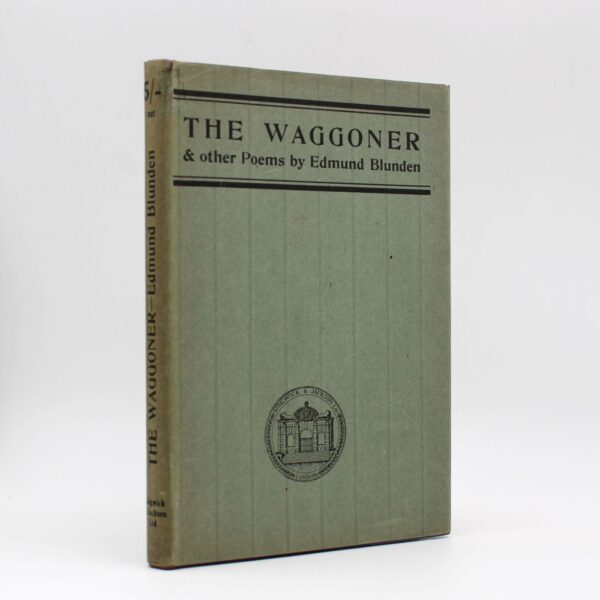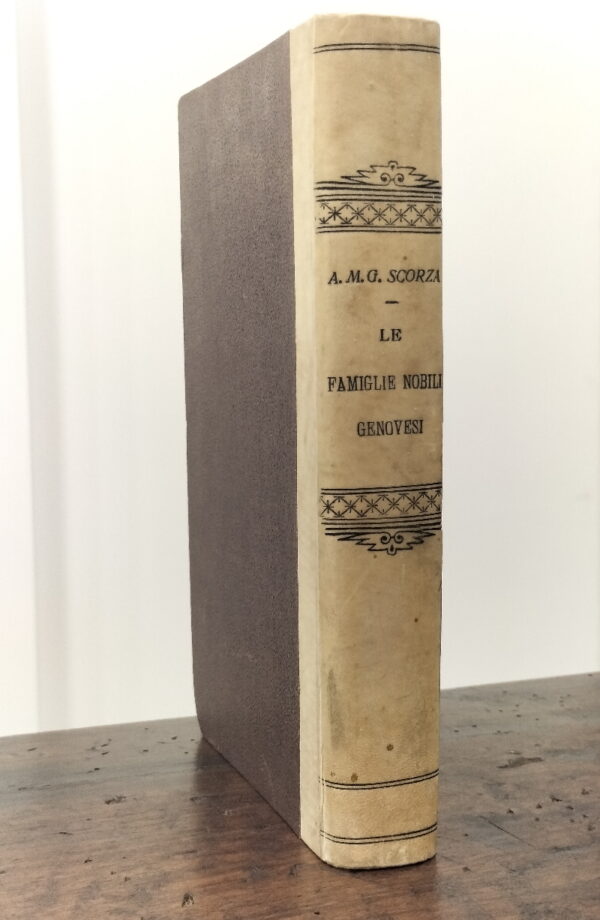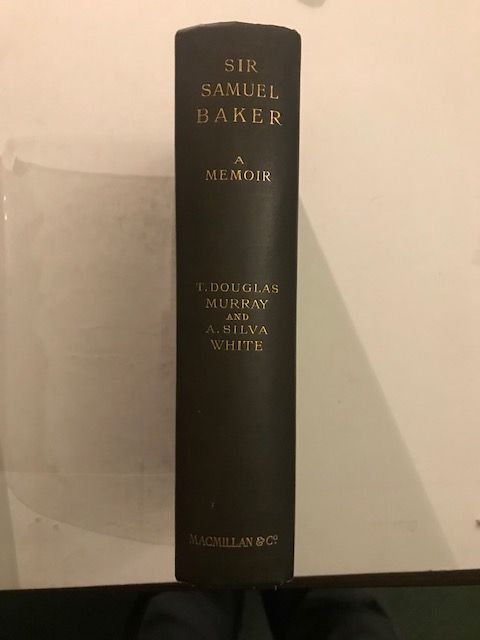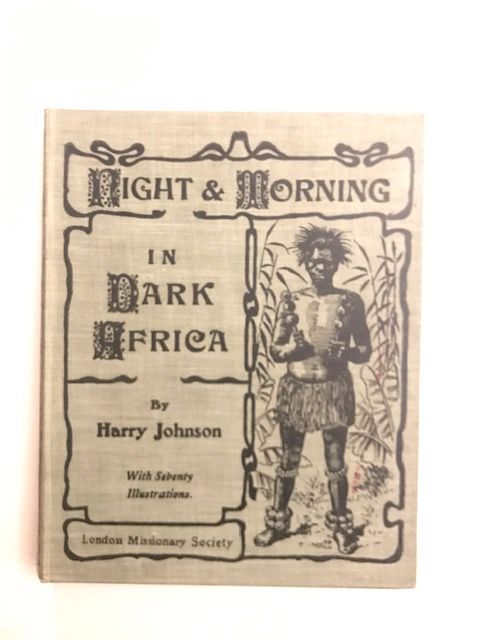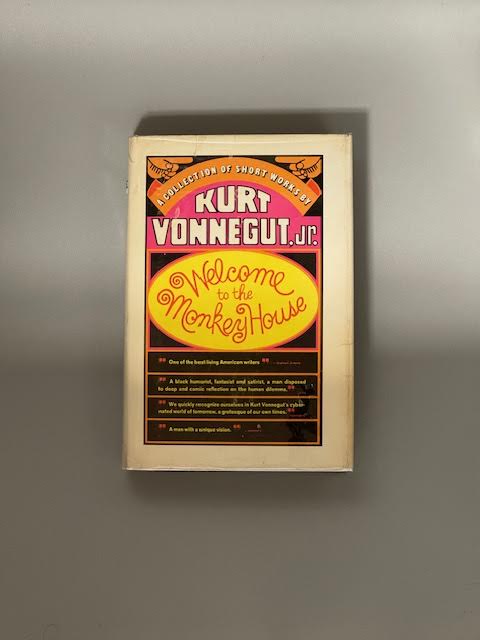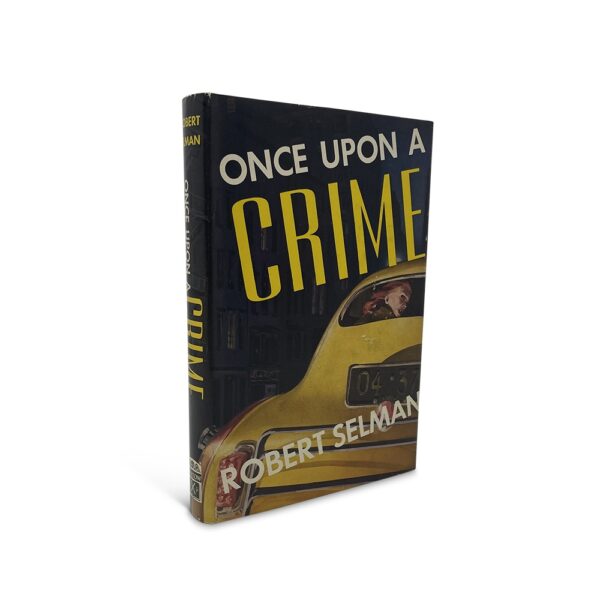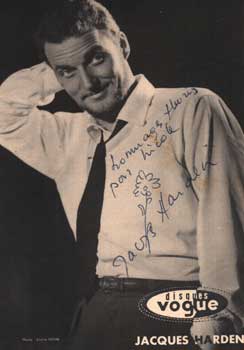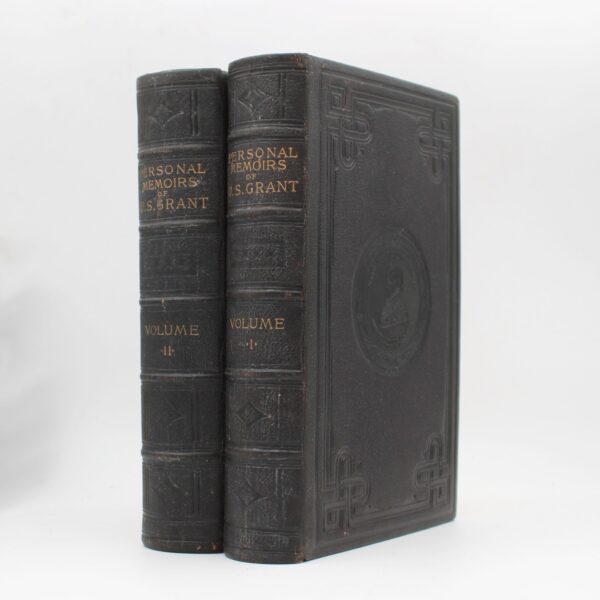
Personal Memoirs of U. S. Grant
Grant, Ulysses S. First edition. Illustrated. 584, 647, [1]pp. 2 vols. 8vo. IN PUBLISHER'S DELUXE FULL TURKEY MOROCCO. The president and Civil War general's remarkable memoir, written in the final years of his life as he was suffering from terminal throat cancer. Suffering both physically and financially, as the result of financial misfortune, Grant began writing his autobiography in the fall of 1884 and finished in July of 1885, five days before his death. Samuel Clemens (Mark Twain) encouraged Grant and shepherded the book to publication through the Webster connection. Eagerly anticipated by a public that had been following Grant's illness in the press, the book was an immediate success upon its release, and has long been considered one of if not the best memoirs written by an American president. Since its publication, it has received acclaim from literary figures including Twain and Gertrude Stein, and from numerous modern American historians and political commentators from Eric Foner to Ta-Nehisi Coates. The publisher's full morocco binding is by far the rarest form of the work and the most expensive format when published. Publisher's deluxe full black Turkey morocco, with blind stamped corner fillets and portrait medallions of Grant on front and rear covers; title stamped in gilt on spine, with additional gilt stamping to edges, with very minor bumping; all edges gilt; marbled endpapers Illustrated. 584, 647, [1]pp. 2 vols. 8vo- $4,750
- $4,750
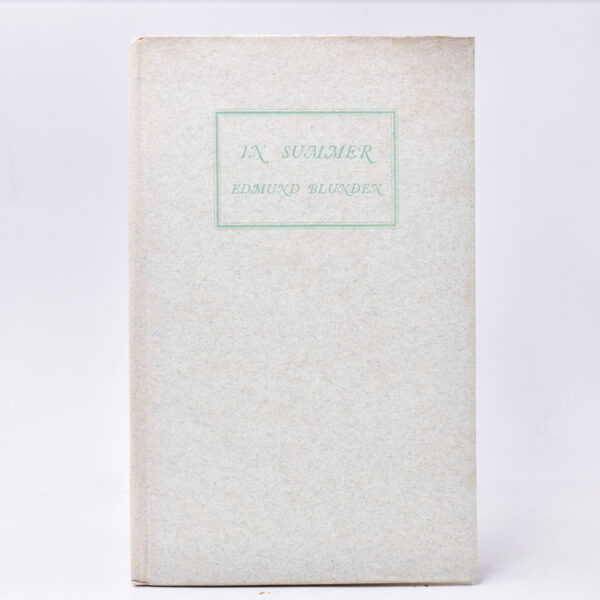
In Summer. The Rotunda of the Bishop of Derry . with decorations by Edward Carrick
Blunden, Edmund First edition, one of 290 numbered copies, signed by the author. [8] pp. First leaf is a blank. 1 vols. 8vo. Kirkpatrick A42a [8] pp. First leaf is a blank. 1 vols. 8vo First edition, one of 290 numbered copies, signed by the author.- $250
- $250
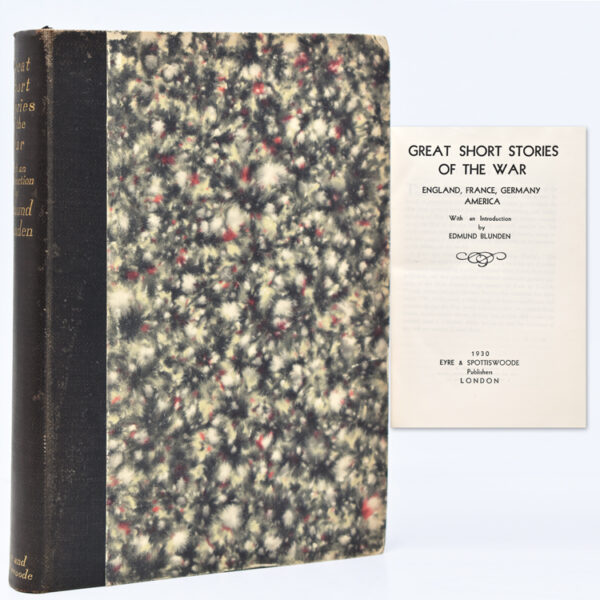
Great Short Stories of the War. England, France, Germany, America. With an introduction by .
Blunden, Edmund, editor First edition, no. 30 of 250 copies printed on India paper, signed and numbered by the editor. 983 pp. 1 vols. 8vo. Kirkpatrick B40b Black buckram spine, titled in gilt, marbled boards. Near fine, bright copy (minor rubbing) without slipcase First edition, no. 30 of 250 copies printed on India paper, signed and numbered by the editor.- $350
- $350

Cannery Row
Steinbeck, John First Edition, First Printing. A spectacular copy. This ORIGINAL untouched, unrestored dustjacket is seldom seen in this amazing shape. The ORIGINAL First Issue dustjacket is rich in color with NO chips or tears. The book is in fabulous shape with the top stain blue to top pages from the publisher vibrant in color with NO fading. The binding is tight and the boards are crisp. The pages are exceptionally clean with NO writing, marks or bookplates in the book. A superb copy from the Steinbeck family library.- $4,000
- $4,000
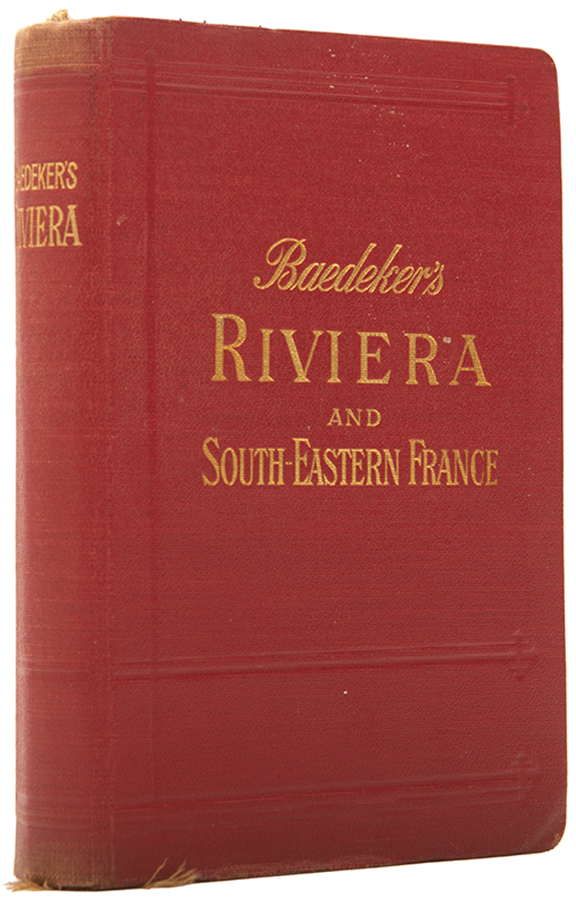
France. Riviera and South-Eastern France and Corsica.
BAEDEKER, John. First edition, xxxvi, 480 pp.with 82 maps and plans,; publisher's red cloth gilt; a very good copy. First and only edition of this title in English. This volume covers a wide area including the Italian Riviera as well as the French. Issued c.1931.- $157
- $157
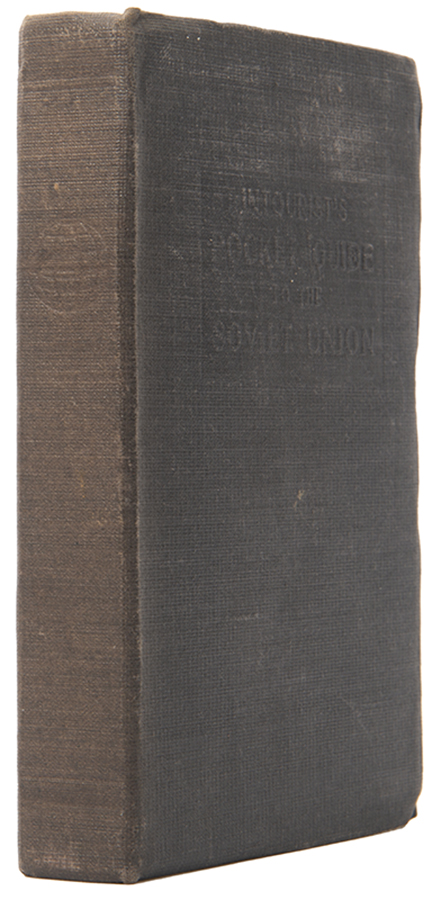
Pocket Guide to the Soviet Union.
[INTOURIST] First edition. Small 8vo, (15 x 10 cm), 706pp, 2 (of 4) folding coloured maps, (lacks maps of Moscow and Leningrad usually inserted loose in a booklet at rear), adverts at rear, slight spotting throughout, previious owner's pencilling inside ; publisher's original black cloth, slightly marked and worn; a very good firm copy. A good example of this interesting Communist guide. Intourist was the Soviet agency established in 1929 to promote the USSR's image overseas. Stalin's Russia wasn't a closed country by any means, although many western visitors arrived as part of delegations sent by trade unions and other sympathetic groups. This guide nearly always lacks the two maps of Moscow and Leningrad inserted loose as a booklet with printed wrappers at rear. The two other maps bound in the book are of the European USSR and the Asiatic USSR.- $182
- $182
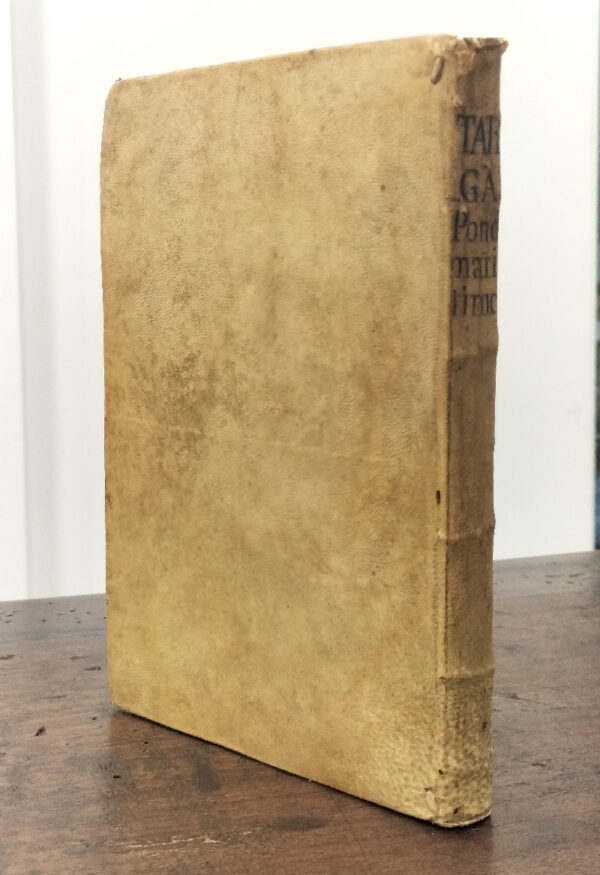
Ponderazioni sulla contrattazione marittima ricavate dalla legge civile e canonica, dal consolato del Mare e dagli usi marittimi. profittevole non solo a praticanti del Foro ma ancora ad ogni sorta di mercadanti e marinari.
TARGA Carlo In-8 (205x130 mm.), pp. (8), 259. Freg. xilogr. al front. Legat. in piena perg. rigida coeva con titolo calligrafato al dorso, tagli spruzzati di rosso. Bell'esemplare. Ristampa (ed. orig. per lo Scionico, in Genova, nel 1672) dell'opera che rese la più grande notorietà europea al Targa. Il giureconsulto genovese ebbe il grande merito di ordinare una materia complessa e all'epoca disorganica come quella evocata nel titolo, fissando i principi del diritto relativi alla fabbrica dei vascelli, alla pesca, ai contratti di comodato di navi, all'accomandita e all'assicurazione, alle polizze, alle lettere di credito e di cambio, ai sinistri e ai naufraghi, agli attacchi pirateschi e agli ammutinamenti. Bibliogr.: Haym, p. 169 (per ediz. orig.). Kress It., 305. Choix, II-518. Bibl. Mansutti, 1582.- $642
- $642

Basilika: The Workes of Charles the Martyr with a Collection of Declarations Treaties and other Papers
Charles I [Wenceslaus Hollar] An attractive first edition which boasts all three double page engravings but lacks the preliminary portrait of Charles I and the engraved general title page. Folio (35 x 24.5m) bound in tree calf, red morocco spine label; the binding a little scuffed and rubbed but perfectly sound and serviceable and pleasing to the eye. Marbled endpapers with the armorial book plate of 'James Greenway' to the front pastedown. Two preliminary blanks precede the printed text which lacks the engraved title page and the portrait of Charles I (A1-2), beginning at A3 with the red-ruled letterpress title page. Otherwise the text collates complete with the three double page plates present - the Carolus plate; Lotha and the Cedar engraving. Noted during collation: small hole below page number to k2; a little staining to the lower outer corner of the text block which becomes slightly more pronounced in the final gatherings. The book comprises two volumes in one as issued: pp [16]120 [2] pp123-460 [8] pp 734 [6] without the inserted leaf of Latin verses after p.458 which Madan notes as not always present. This is an important work which marks the change of fortunes of the Stuart dynasty following Charles II's restoration to the throne and the rehabilitation of his father. Please contact Christian White Rare Books Ltd for more information or images of this item- $851
- $851
![Pompeii [A Collection of Albumen Photographs]](https://rarebookinsider.com/wp-content/uploads/2024/06/31893605667-600x800.jpg)
Pompeii [A Collection of Albumen Photographs]
Giorgio Sommer A tourist souvenir of Pompeii from the 1870s containing 70 albumen photographs of Pompeii, its ruins, murals and some of the sculptures that ended up in Naples' museum together with a photographic frontispiece. Sommer (1833-1914) was one of Europe's most prolific and important photographers who had at least three studios in Naples, near to Pompeii itself. Small album (23x18.5cm) bound in blind-stamped cloth, rubbed to edges and corners; paper endpapers with browning and dust spotting. The indivdual images (14x10.5cm) are mounted on card leaves, usually with a printed number and pencilled title in Italian. A few figures appear along the 'Strada delle Tombe'. Images include general views, villas, theatres, human figures and the famously contorted dog as well as Cave Canem. An impressive collection which focusses on Pompeian murals in the final section plus a few images of Herculaneum. Please contact Christian White Rare Books Ltd for more information or images of this item- $458
- $458
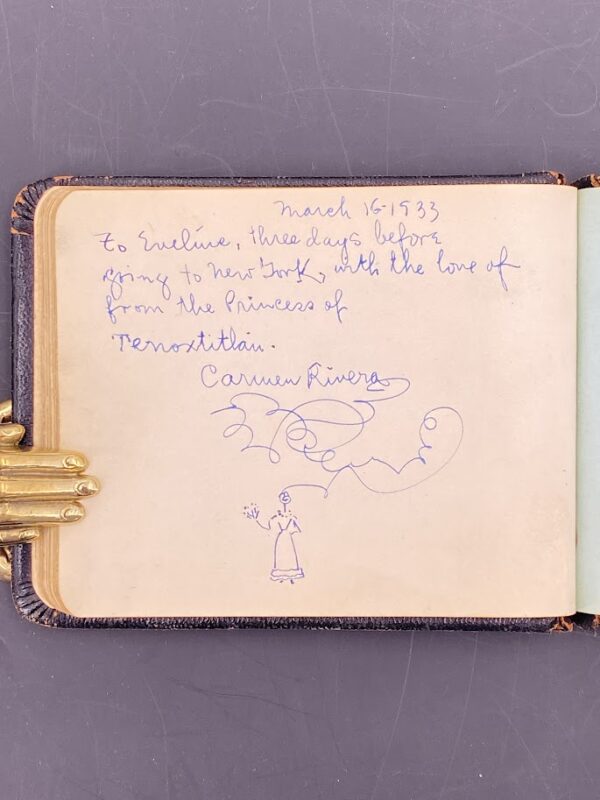
FRIDA KAHLO & DIEGO RIVERA IN DETROIT Evelyn Cohen’s Notebook with Drawings by Kahlo and Rivera
Frida Kahlo - Carmen Rivera; Diego Rivera An extraordinary memento of the creative presence of the artistic super-couple Frida Kahlo and Diego Rivera - 'equals and accomplices' as they were described - in the mid-western city of Detroit, early in 1933. With these drawings into a young woman's autograph album, made a few days before their departure for New York, Kahlo and Rivera marked the close of a period of great artistic achievement for them both. Three days before these drawings were created Rivera finished his industrial frescoes and Kahlo ended her anguished sequence of Detroit canvases. In her drawing and inscription Kahlo has overtly recognised this transitional moment. Her miniature figure of a holds out flowers ('I paint flowers so they will not die' - Kahlo) and in her inscription she looks forward to moving to New York. Kahlo emphasises her Mexican identity by calling herself the 'Princess of Tenoxtitlan' (sic) and signing herself 'Carmen Rivera' as she did on her Detroit paintings. To the album Rivera contributes two remarkable drawings: a mask-wearing man who resembles closely his masked automotive engineers on the north wall of what is now Rivera Court at the Detroit Art Institute. In his second figure Rivera depicts a serene, upwards-gazing African-American man viewed in profile with his work mask pushed nto his forehead. Together Kahlo and Rivera spent much of 1932 and early 1933 in Detroit where Rivera had been commissioned to create a series of frescoes for the Detroit Art Institute which would draw upon the city's industrial heritage. It is generally acknowledged that while in the city both artists hit 'a career peak' as Rivera completed his DIA mural and Kahlo worked intensely on a series of portraits dealing with her personal struggles. Rivera remembered how: 'Frieda began work on a series of masterpieces which had no precedent in the history of art. Never before had a woman put such agonized poetry on canvas as Frida did at this time in Detroit.' Whilst they lived in the city the couple were feted and entertained by Detroit's elite. Kahlo in particular responded provocatively to her American hosts: 'the expansive Rivera speaking Spanish and French and demanding all the attention, with the petite and caustic Kahlo dressed in colorful Mexican costumes. At Henry Ford's sister's home, Frida talked on about the wonders of communism. At a dinner at Henry Ford's she asked the anti-semitic industrialist if he was Jewish.' One of the other elite Detroit households who entertained Kahlo and Rivera was the Cohen family, parents of Evelyn Cohen who, on the evening of March 13, 1933, persuaded Kahlo and Rivera to inscribe her little album. This album captures a pivotal moment in art history. PROVENANCE: Evelyn Cohen and by descent. EVELYN COHEN'S ALBUM: Padded black roan (15x11.5cm), maker's stamp of 'Horn Est 1846, [ff] 48, alternating pink, yellow, blue leaves, c 60 entries - the entries do not follow chronological order but range over the years from 1922-1934 including, school teachers, friends, musicians, written in English and sometimes in Hebrew. Kahlo's miniature of a woman with flowers is balanced by her thoughtful inscription written in faulty English: 'March 16. 1933 To Eveline, three days before going to New York, with the love of from [sic] the Princess of Tenoxtitlan Carmen Rivera'. Below this Kahlo has placed her tiny figure of a woman holding a bunch of flowers away from her body and a huge swirling pen line that connects the woman with her signature and inscription above. Using blue ink Rivera has made two drawings: the first depicts a man wearing a gas mask and goggles, very similar to the masked figure he muralled on the automotive north wall of what is now Rivera Court at the Detroit Art Institute and wrote below: 'D.R. To beautiful Eveline'. On the adjacent leaf Rivera has sketched an African-American man in profile, apparently wearing goggles which have been pushed up onto his forehead and inscribed 'Diego Rivera Detroit March 16 1933'.- $15,060
- $15,060
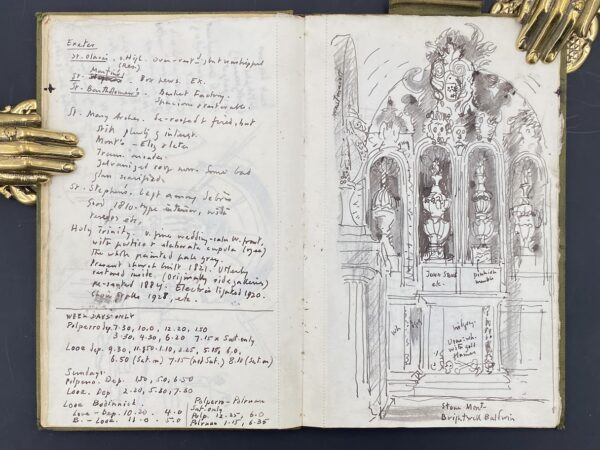
NEO-ROMANTIC LANDSCAPES, ENGLISH CHURCHES & ARCHITECTURE IN A WARTIME SKETCHBOOK
John Piper A remarkably rich wartime sketch-book in which John Piper recorded his 1943 summer tour of Devon and Cornwall in the company of Geoffrey Grigson, sketched Welsh landscapes as well as the Victorian villas and churches of the English Midlands while he stayed at Renishaw Hall, home of his friends Edith and Osbert Sitwell. Piper's sketches include churches in Exeter and West Ogwell in Devon, Lackington (later worked-up into an illustration to Betjeman's Guide to English Parish Churches) and Hemington in Leicestershire. From Cornwall Piper has sketched a ruin that would evolve into his 1943 'farmyard chapel' aquatint at Botallack and there are around a dozen sketches and watercolours of Piper's beloved Victorian villas, soon to be the subject of his collaboration with J M Richards in Castles on the Ground. Alongside the sketching, note-taking and train times, Piper also includes reading notes relating to Ruskin's Stones of Venice. Almost all of Piper's archive went to the Tate Gallery making this a rarity on the open market. PHYSICAL DESCRIPTION Green cloth-effect paper over boards (23.5x15.5cm), spattered with paint, with a now-loose elastic closure band and a pencil sleeve. The sketchbook has the label of the London stationer, C Robertson and Co 'Sketch Book Hand Made Water Colour Paper', priced in pencil '5/8' with a pencilled note in Piper's hand opposite relating to his friend the architectural historian Nikolaus Pevsner. The sketch book's pages are of thick wove paper, designed to take water-colour, with a line of perforations 1cm from the gutter, similar to Piper's other notebooks that Piper used for sketching in the field (see Plates 76/77, Piper's Places, 1983). The manuscript comprises 21 leaves, one inserted drawing and one inserted postcard, with a similar number of stubs where pages have been removed - two of which have residue of black wash, similar to extant watercolour landscape sketches that survive in the sketchbook. Very much work in progress, the sketchbook records several facets of Piper's practice in 3 pages of pencil drawings; 7 pages of pen and watercolour wash, 12 pages of ink drawings and 5 pages of notes - 28 pages in total, with 14 blanks - mostly the versos of the more substantial watercolours. PROVENANCE: given by John Piper to Orde Levinson, friend and author of The Prints of John Piper: A Catalogue Raisonne, 1923-1991. NARRATIVE: WEST COUNTRY The first part of the sketch-book records Piper's July 1943 trip to the west country and into Cornwall that he took with Geoffrey Grigson. The sketchbook starts in Devon 'between Torbryan and Denbury' where Piper sketched, annotated and watercoloured a late Georgian house; continuing a mile up the road to the church at West Ogwell which is the subject of an ink sketch with extensive architectural annotation: 'dark box pews pitch pine (mostly removed) Jac.[obean] pulpit.' In Exeter Piper visited 6 of the city churches, particularly enjoying 'Holy Trinity. v fine wedding-cake W. front with portico & elaborate cupola (ogee) the whole painted pale grey.' and opposite these descriptions he made a carefully worked ink sketch of a blank arcade of niches, each with its urn and surmounted by a stone coat of arms. Below his church notes (recto), Piper has jotted down train (or perhaps bus) times from Exeter to Polperro and Looe in Cornwall. Once in Polperro Piper sketched a house on 'Meadow Terrace', adding additional annotation in orange crayon. The first of the sketchbook's watercolours follows this sketch, depicting a shower of rain over a coastal outcrop - perhaps from the south Cornish coastline near Polperro. Piper and Grigson's journey west reached its furthest point with two ink sketches of Hall Place, Botallack. The first of these is an exterior view which is a preparatory sketch for his aquatint completed in the same year (Hall Place, Botallack, Levinson 29), a sketchy rendering with three annotations and on the following leaf an internal view of the same buildi- $19,643
- $19,643
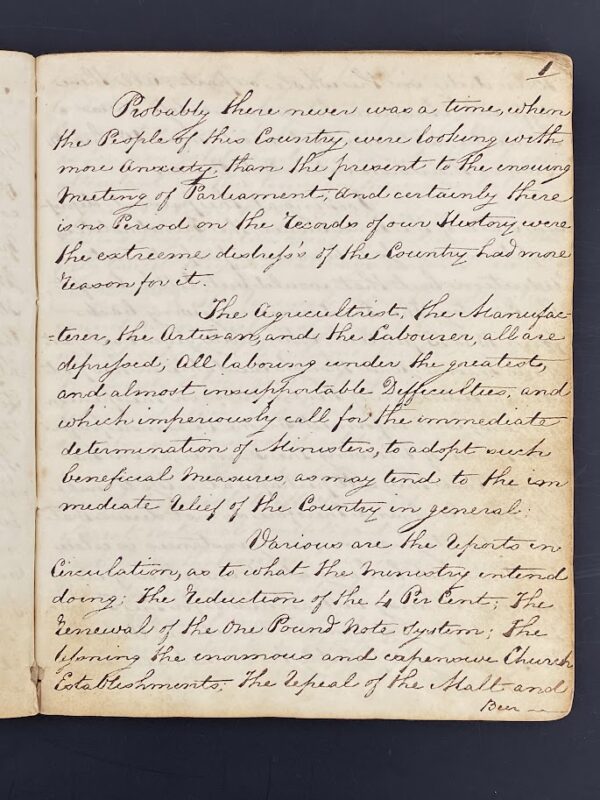
‘THE BOROUGH MONGER SYSTEM IS DEROGATORY AND CORRUPT’ Manuscript Polemic in Favour of Parliamentary Reform sent to a Whig Peer
Luke Batten; Thomas Brand, Lord Dacre. A singular early nineteenth century letterbook that centres on a polemical essay sent to Thomas Brand, 20th Baron Dacre, on the state of the British nation and the need for multiple reforms, notably parliamentary reform which would be achieved in the Great Reform Act only two years later. To the rear of the volume Dacre's thoughtful reponse to his former Hertfordshire neighbour and perhaps constituent has been tipped in. PHYSICAL DESCRIPTION Quarto format, full fawn limp leather, ruled and roll-tooled in blind, remnants of hand-written white paper title label pasted to front cover; soiled and rubbed, losses to spine, corners worn and rounded. Bands of browning, from glue, to endpapers which are peeling at head and tail of front hinge, small losses, but wrappers remain firmly attached. 46 leaves 92 pages blank paper; numbering begins on first page, running f. 1, pp. 1-4, ff. 5-41; text continuous, except three blank pages between entries, script ends on [p. 80], followed by 7 blank leaves. The author has compiled an index of letters and subjects to the verso of the front endpaper. Script, in brown ink, in an attractive, open and (mostly) legible hand; toned with some foxing, ink smudges and crossings-out. Overall, clean and a 3 page letter, addressed 'Chesterfield/ Tuesday' and signed "Dacre" tipped in to rear: closed tears to both leaves, with repairs, small losses to second leaf, which has been pasted to another page to reinforce it, text remains legible. TEXT: Batten writes in a lively and well informed style. He has copied in full his letter-essay to Dacre (pp. 44; dated 01.02.1830, from St Albans) which makes up most of the book and argues for church reforms, changes to beer taxes, the civil list, game laws, enclosure bills and licensing. But it is parliamentary reform that rouses him to fury: 'The Borough Monger System is Derogatory and Corrupt. While Manchester, Leeds, Sheffield, Birmingham and other large Towns. ought to return members. are denied the privilege.' Dacre's response to this letter is polite and respectful, acknowledging 'your observations upon the present state of the country.' There are also two shorter letters to Dacre and Lord Althorp (1830), in similar vein, discussing beer and leather taxes. The penultimate section, written in lighter ink and another hand, lists the reforms that have been implemented with corresponding folio numbers to relevant sections in Batten's letters; It closes with: 'Remarks on the Law of Militia, Legacy, and Probate Duty's' (c. 1847). A letterbook with resonance for the present day in capturing a testing time for Britain, when 'inhabitants of this once envied and almost adored island are looking with watchful, and penetrating eye, on the conduct of their rulers.' CONTEXT The historical record is scant for Batten, though he served as a Poor Law overseer in St Albans in 1838. Thomas Brand, 20th Baron Dacre (17741851) was a British peer and Whig politician. Before succeeding to the barony of Dacre in 1819, Brand held the seats of Helston and Hertfordshire. He lived at The Hoo, Hertfordshire. Please contact Christian White Rare Books Ltd for more information or images of this item- $393
- $393
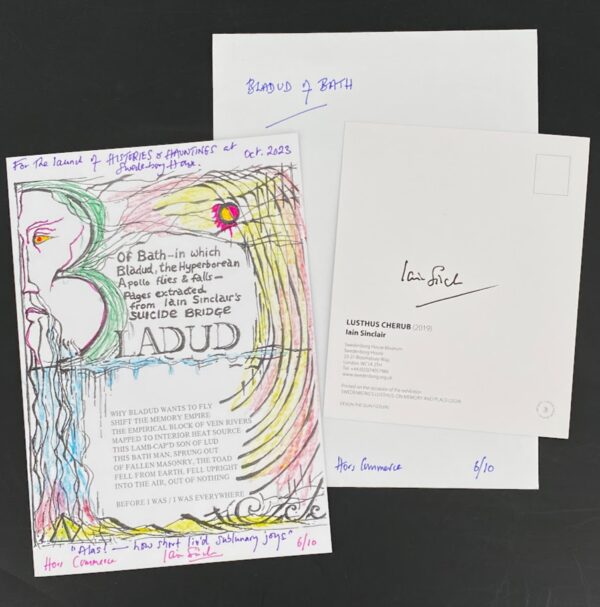
No6/10 COPIES – HORS COMMERCE Bladud of Bath
Iain Sinclair No 6 of 10, 'hors commerce' - not intended for sale - of these Extracts from 'Suicide Bridge', originally published in 1976 by Zero's Fool Press, reprinted here on the occasion of the exhibition 'Histories & Hauntings: Correspondences from the Whitechapel Gallery (1974) to Swedenborg House. Through image and action.' (13 October to 21 December 2023). Bifolium single sheet, folded once into 4pp., 8vo. This is one of 10 hors commerce copies numbered, signed, and hand-coloured by Sinclair with a signed postcard and contained within an envelope also numbered and labelled in Sinclair's hand. Please contact Christian White Rare Books Ltd for more information or images of this item- $144
- $144
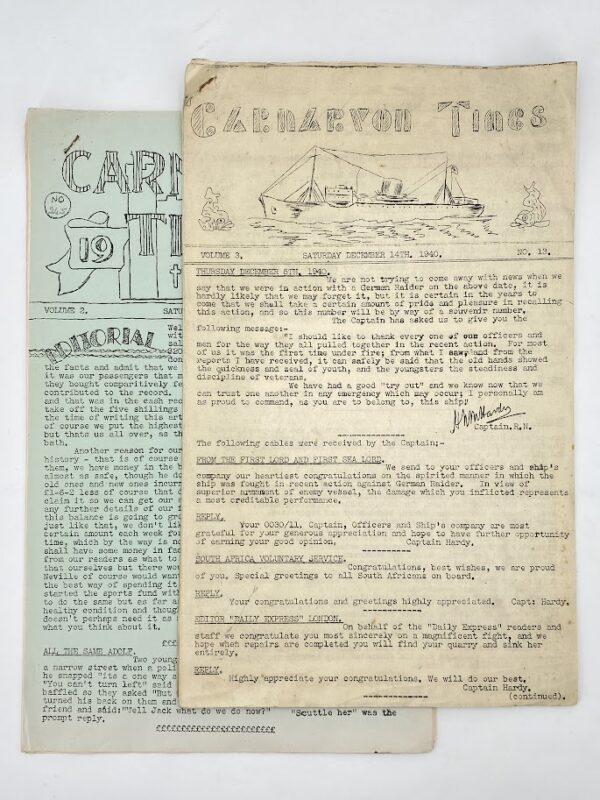
SHIPBOARD WORLD WAR II JOURNAL REPORTING A NAVAL BATTLE IN THE SOUTH ATLANTIC ‘Carnarvon Times’
Captain Hardy and Crew Two issues of an unrecorded shipboard magazine which was printed in the south Atlantic onboard HMS Carnarvon Castle, an ocean liner which was commissioned as an armed merchant cruiser in 1939. The second of the issues, Vol 3 No 13, December 14th, 1940, was produced in the aftermath of HMS Carnarvon's five hour running battle with the German cruiser Thor in which she sustained 27 hits, 6 dead and, 7 with serious wounds (this magazine records a different total from Wikipedia) and another 30 'slightly wounded'. The imprint begins with a congratulatory message from Captain Hardy followed up by the First Sea Lord, Admiral Pound: 'In view of superior armament of enemy vessel, the damage which you inflicted represents a most creditable performance.' Shortly afterwards the Carnarvon put into Montevideo for repairs with steel plate reportedly salvaged from the German cruiser Admiral Graf Spee. First issue, Vol 2, No 11, printed on rectos of 6 sheets of foolscap of different colours, stapled and numbered in pencil '245'. Contents a mixture of shipboard news and international bulletins together with comic vignettes and jokes aplenty. Volume 3, No 13, Saturday December 14th, 1940, [pp] 11, printed on both sides of six sheets of yellow foolscap. Dominated by news of the recent action with Thor and the time spent in Montevideo under repair and concluding with a dignified Roll of Honour. Please contact Christian White Rare Books Ltd for more information or images of this item- $229
- $229

Deed
DEED FOR LAND CLOSE TO, OR ABUTTING GEORGE WASHINGTON'S FATHER'S PLANTATION True copy of a November 28, 1737, deed for property adjoining Pope's Creek, Westmoreland County, VA, sold by Morrice Veal II to Edward Bush. Circa 1743.3 pages, holograph, on folded sheet, 7½ by 12½ inches. The deed is docketed: "Veal to Bush Copy Deed F[or] Colo. Washington." This is Augustine Washington, Sr. (1694-1743) father of George Washington, who was often referred to as "Colonel Washington." Augustine had moved to Pope's Creek in 1718. Wakefield, the Manor House built by Augustine at Pope's Creek Plantation in 1722, was the birthplace of George Washington. By 1737 Edward Bush owned 80 acres of land on Pope's Creek that formerly belonged to Augustine Washington. Thus, the property referenced in this deed is likely land owned by Veal that bordered Washington's land and Bush was expanding the land he had earlier purchased from Washington. This true copy is signed by Colonel George Lee (1714-61) as County Clerk [of] Westmoreland, thus dating this true copy between April 1742 (when Lee became Clerk of the County) and April 1743 (the month Augustine Washington died). Interestingly, George Lee and his wife, Ann Fairfax Washington Lee, (George Washington's former sister-in-law) owned Mount Vernon and leased it to George Washington. The deed reads, in part: "THIS INDENTURE made the 28th day of November [1737] in the 11th year of the Reign of our Sovereign Lord George the Second by the grace of God of Great Britain, France & Ireland, King, Defender of the faith &c., Between MORRICE VEAL of Prince William County of one part and EDWARD BUSH of Westmorland County of other part; Witnesseth that MORRICE VEAL for the sum of five thousand pounds of good, Tobacco in hand paid him. confirm unto the said EDWARD BUSH. One hundred acres of land be the same more or less situated in County of Westmorland & Washington Parish being part of a parcel of land formerly granted to MORRICE VEAL, Father of the aforesaid VEAL for two hundred acres, beginning at the head of POPES CREEK with all houses, out houses, and Tobacco houses, with all Orchards, fences, and gardens thereon In Witness the parties above mentioned have interchangeably set their hands and seals the day and year above written MORRIS VEAL. . . .[Witnessed by] NICHOLAS MINOR. GERRARD DAVIES, and WILLIAM BERKLEY. Recorded the Seventh day of December 1737, pr. G. TURBERVILLE, C. C. W. Copy Test: George Lee C.C. W." John Washington, the grandfather of Col. Augustine Washington (and great-grandfather of George Washington) initially acquired Pope's Creek from his father-in-law, Nathaniel Pope (who is the namesake of Pope's Creek). Colonel Augustine Washington eventually inherited 150 acres of the Pope's Creek property and moved there in 1718. He began acquiring adjoining property and in 1722 began work on a manor house (named Wakefield). The manor house at Pope's Creek Plantation was located less than a mile south of the creek's confluence with the Potomac River thus it was "at the head of Pope's Creek," as is the Veal/Bush property described in this document. Colonel Washington's manor house eventually controlled a plantation of 1,300 acres with several outbuildings and 20 to 25 slaves. George Washington was born at this manor house in February 1732. Edward Bush (b. 1714) was a carpenter who was born and raised in Westmoreland County. Given where he lived, it is likely that he did carpentry work for Augustine Washington at the Pope's Creek Plantation. In 1742 Edward sold his Pope's Creek property and moved to Culpepper, VA. Those witnessing that deed were relatives and close friends of the Washington family. Less is known about Morrice (aka Maurice or Morris) Veale II (c. 1676-1750). He was the son of Morrice Veale I. In 1707 Morrice Veale II (and John and William Veale) sold an acre of land to Nathaniel Pope (1st cousin of Augustine Washington) upon which Pope built a grist mill. In 1728 Augustine purchased- $5,500
- $5,500

Encyclopedie Automobile
SATIRICAL LITHOGRAPHS OF EARLY FRENCH CARSEncyclopédie Automobile: La Belle Epoque et Les Pionniers de L'Automoile. Illustrated with 16 original color lithographs by Guy Sabran. Oblong Folio. Original pictorial olive green folding cover; title in a frame representing the entrance to the Parisian metro station. Guimard, Champrosay, Editeur, Paris, 1956. First Edition.Loose illustrations, as issued, inserted in folding cover. A wonderful series of color lithographs satirizing early French car culture. Illustrations are: Coupé de Ville Renault 1905; Zèbre 1904; Double Phaéton Morse 1903; Double Phaéton Delaunay-Belleville 1911; Landaulet d'Amédée Bollée 1878; Phaéton Panhard Levassor 1891; Léger George Richard 1893; Peugeot Grand Luxe 1895; Delahaye 1897; Le Petit Phaéton Renault 1898; Cabriolet Chenard et Walker 1904; Le Phaéton Bardon 1899; LA "Jamais Contente" de Jenatzy 1899; Phaéton Grand Sport Panhard 1899; - La Limousine de Ville de Léon Bollée 1899; Taxi Renault 1905. Covers slightly soiled; spine and corners worn; some slight warping to a few lithographs; some with tape at corners, having been crudely hung, not in any way damaging the images; o/w bright and clean.- $275
- $275
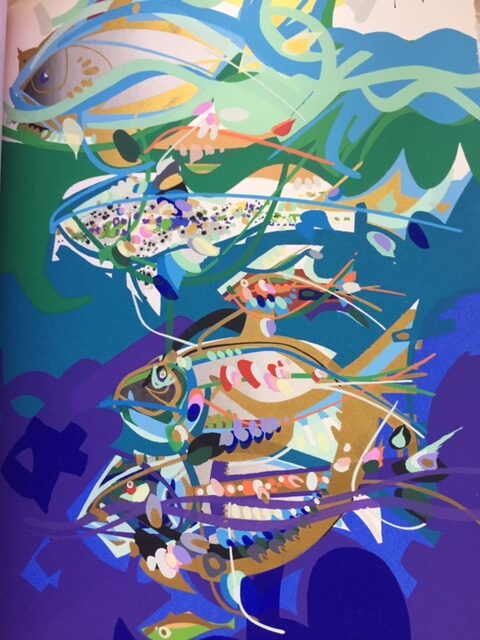
Le Bateau Ivre. (The Drunken Boat).
Illustrated with 36 color plates and text manuscript by Raymond Moretti. Folio. Cream-colored vellum binding, with Moretti illustration on cover; enclosed in ¼-leather-backed marbled board box, with vellum spine label. Chez Joseph Pardo à l'enseign du Sefer, Nice (1966). One of 350 copies on vellum pure rag, with an extra suite of 11 full-page color plates on Japan paper. Copy #298, dedicated and signed by Moretti. Laid-in is a "Certificat de Garantie" from Joseph Pardo. Spine of box chipped and frayed; edges chipped; book in fine condition, with clean, bright pages and plates. Rare- $2,750
- $2,750

Oliver Twist in 3 volumes
Charles Dickens A very good second edition of Charles Dicken's Oliver Twist in three volumes. Original cloth with gilt lettering on the spines. Rebacked preserving cloth. Twenty four illustrated plates with spotting and staining. Otherwise generally clean contents. A couple of tears. 8vo- $1,306
- $1,306

The Two Towers, being the second part of The Lord of the Rings
J. R. R. Tolkien A first edition, first impression of The Two Towers in very good condition. Original red cloth boards with dulled spine and gilt lettering. Previous owners inscription of initials, "J. S. Turner" on the front free and half title page. Stamp marked "Head of the department of English University of Dacca" on the title page. Clean contents and intact map in situ. 8vo 352pp.- $2,809
- $2,809
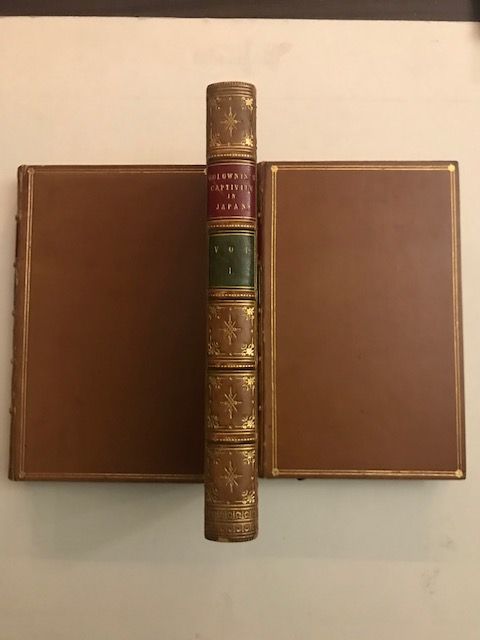
MEMOIRS OF A CAPTIVITY IN JAPAN during the Years 1811, 1812 and 1813, with observations on the country and the people.
GOLOWNIN Vasili. Second Edition, 3 vols, pp lv, lxxxiv, 315; 356; (ii), viii, 302; contemporary tan calf, aeg, near fine. First Edition to have all 3 volumes printed at the same time.- $1,960
- $1,960
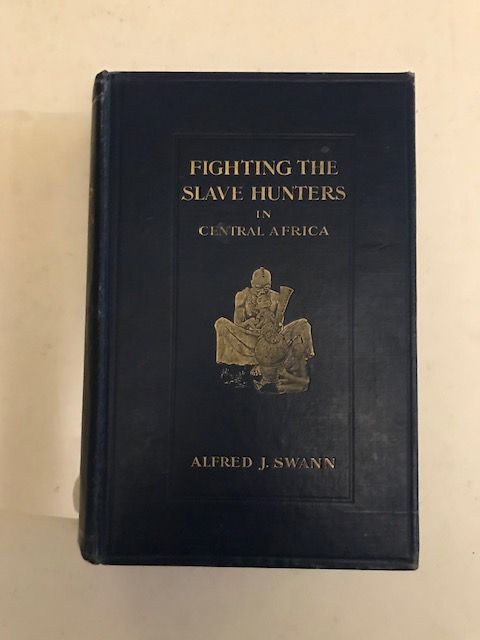
FIGHTING THE SLAVE-HUNTERS IN CENTRAL AFRICA; a Record of Twenty-Six Years of Travel and Adventure round the Great Lakes and of the Overthrow of Tip-Pu-Tib, Rumaliza and other great Slave-Traders.
SWANN Alfred J. FIRST EDITION, large 8vo, pp 359, folding map, frontispiece, illustrations, original blue cloth, gilt vignette, excellent.- $509
- $509
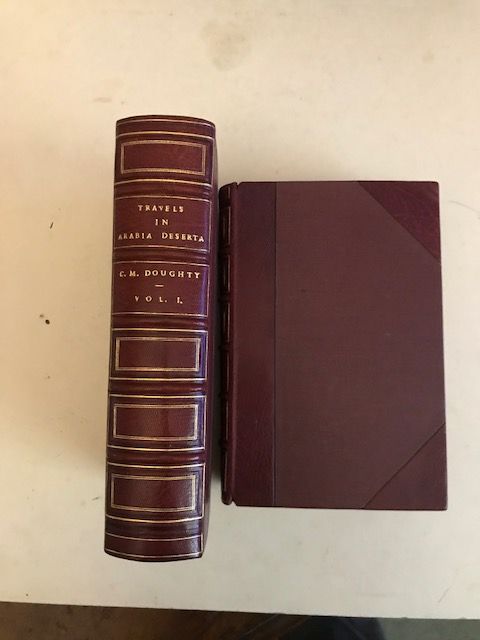
TRAVELS IN ARABIA DESERTA.
DOUGHTY Charles M. FIRST EDITION, 2 vols, 8vo, pp xx, 619, [4] appendix, advertisements; xiv, 539, [3] appendix, 543-690 Index and Glossary of Arabic Words; folding map in pocket of lower cover Vol 1, dissected and laid on linen as issued, numerous illustrations (4 folding), recent red/brown half morocco, small round library stamp on verso of title-page, text clean.- $2,547
- $2,547
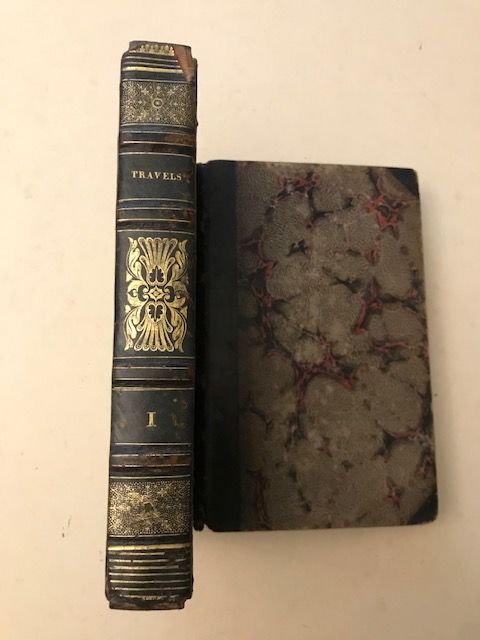
TRAVELS IN TURKEY, EGYPT, NUBIA, AND PALESTINE; in 1824, 1825, 1826, and 1827.
MADDEN Richard R. FIRST EDITION, 2 vols, 8vo, pp xvi, 401; viii, 398; hand-coloured frontispiece (author in Syrian costume), contemporary green half calf, some wear to head and tail of spine, very good and clean. "The author compares his letters to those of Lady Mary Wortley Montagu and discusses the difficulty of combining accurate observations with literary elegance: 'the refinement of her enthusiasm prevailed over the correctness of her descriptions'. Madden had trained as a surgeon, though he never practised in England, but because of this he was able to enter areas closed to most Europeans, mainly the harem and some slave bazaars. He travelled in the Levant from 1824-27. His work also contains much information on Egypt and Egyptology." Blackmer Blackmer 1056; not in Abbey- $751
- $751
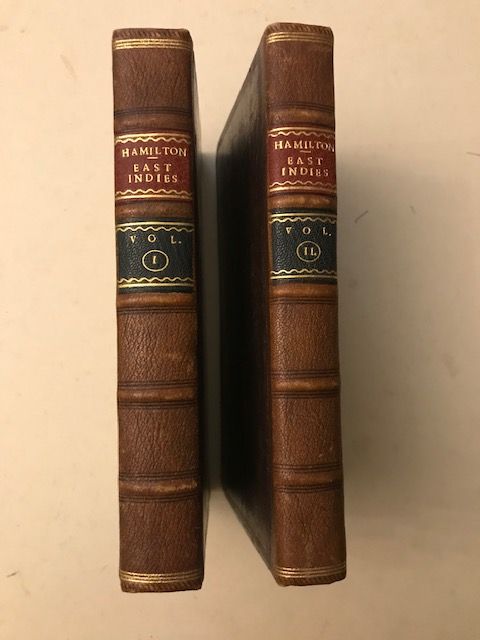
A NEW ACCOUNT OF THE EAST INDIES; Giving an Exact and Copious Description of the Situation, Product, Manufactures, Laws, Customs, Religion, Trade, etc of all the Countries and Islands, which lie between the Cape of Good Hope and the Island of Japan.
HAMILTON Alexander. Second Edition, 2 vols, 8vo, pp xxix, ix, 396; xii, 309, 10: 8 folding engraved maps (1 map with small tear in fold), 11 plates, some slight browning, contemporary brown calf, recently re-backed. Hamilton went to sea, in his own words: "very young", in 1688 and travelled as far as the Barbary coast before basing himself in Surat and trading and travelling all over the Indian Ocean. He made a reputation for himself as a foul-mouthed, resourceful and bold operator fending off Baluchi robbers, treacherous governors and Indian pirates. Goldsmiths 6522; Cordier 890; Mendelssohn (1979) II, 492- $4,572
- $4,572
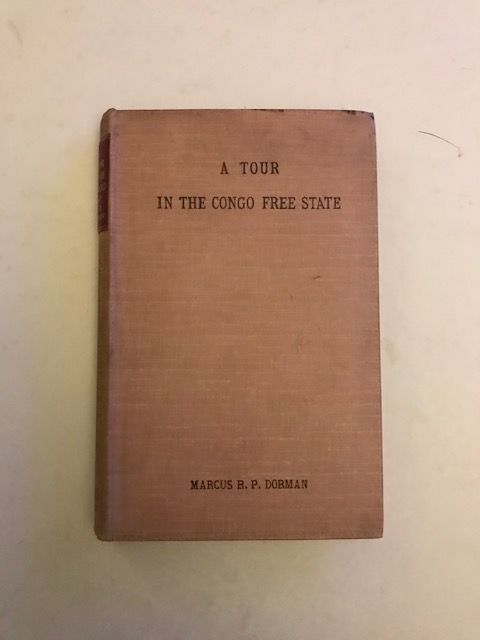
A JOURNAL OF A TOUR IN THE CONGO FREE STATE.
DORMAN Marcus R P. FIRST EDITION, 8vo, pp viii, 192, map, plates, original beige cloth, recent red morocco label, scarce. The author was an adventurer who decided to travel around the Congo. He found the people hospitable and kind. He did some hunting during the trip, and left the Congo having much admiration for the country.- $588
- $588
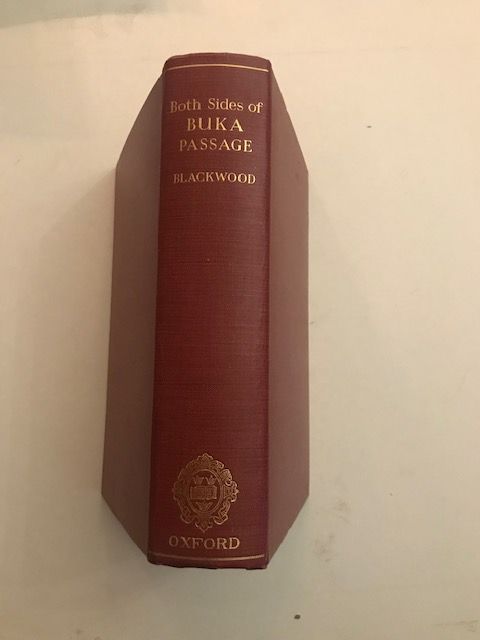
BOTH SIDES OF BUKA PASSAGE; an Ethnographic Study of Social, Sexual, and Economic Questions in the North-Western Solomon Islands.
BLACKWOOD Beatrice. FIRST EDITION, 8vo, pp xxiii, 624, 80 plates, map, tables, illustrations, original red cloth, light staining to top edge, dust-jacket (very good), clean.- $457
- $457

SIX MONTHS AT THE CAPE or Letters to Periwinkle from South Africa
Ballantyne, R. M. Ballantyne, R[obert] M[ichael]. SIX MONTHS AT THE CAPE or Letters to Periwinkle from South Africa. With 12 illustrations by S. E. Waller (from sketches by the author). London: James Nisbet & Co., 1879. First Edition. 8pp Nisbet catalogue at rear. A Very Good example of this apparently scarce title, minor wear to the extremities, a firm copy retaining excellent eye appeal. Contemporary owner's ink signature and tiny smudge to ffep. Set in the colony of South Africa and based on Ballantyne's personal experience there, this tale is filled with the author's usual geographic delights. He takes particular relish in the description of an Ostrich hunt (as depicted in gilt on the front cover).- $250
- $250
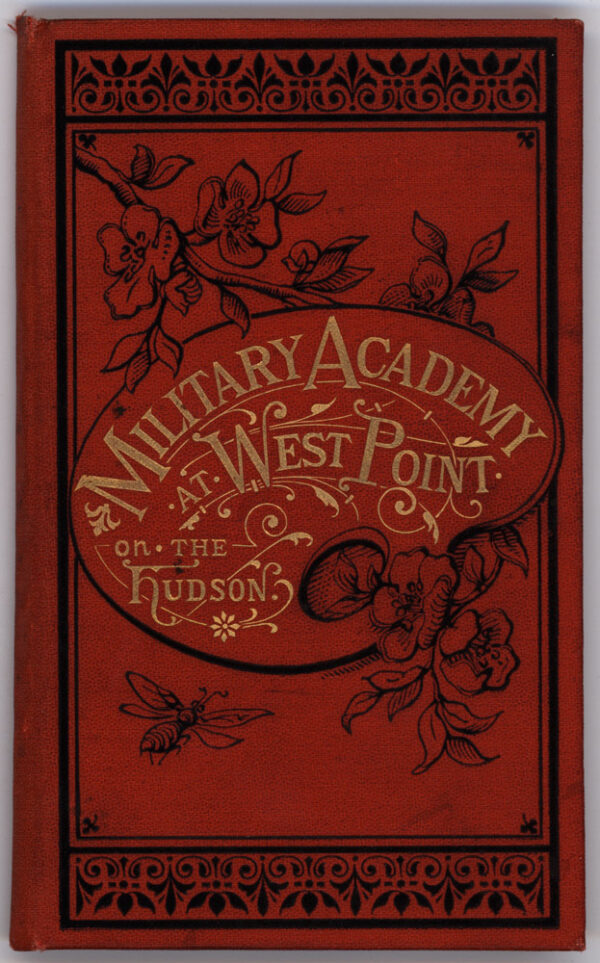
Military Academy at West Point on the Hudson
Glaser, Louis Hardcover. 24mo (5.5" 3.25"), red cloth, stamped in black and gold. Accordion strip, 19 lithographic plates. Three page catalog of Witteman Bros. souvenir albums pasted in at rear. CONDITION: Very good, first plate partially detached from inside of front cover. A souvenir album of views of the Military Academy at West Point on the Hudson, showing the parade ground, barracks, and other such scenes.- $125
- $125

Southwest Louisiana on the Line of the Southern Pacific Company
Knapp, S. A., et al. 8vo (9" x 6"), printed tan wrappers. 71, [2] pp., illus. Faded agent stamp on front wrapper. CONDITION: Very good, re-backed, chips to edges of wrappers neatly filled in, one minor stain on p. 37. An appealing pamphlet picturing and detailing Southwest Louisiana for the prospective settler and capitalist. The text offers a full description of Southwest Louisiana along the line of the Southern Pacific Railroad, where some 10,000 Northerners have located homes. Covered here is the production of sugar; fruit growing (several letters concerning fruit growing in the state are reproduced); truck farming; the climate and its "advantages," and the cultivation of rice on the prairies (including a list of rice planters in the area and the number of acres they own). Also detailed are Southwest Louisiana's grasses, machinery, "safe and profitable investments," Lake Charles College, feed for stock ("the problem of cheap feed for stock"), value and price of land, Southern homes, Joseph Jefferson's Orange Island (near New Iberia), the abundant plant Palmetto, cotton, timber, Lake Charles, minerals, topography, roads, water, and insects. A number of Louisiana regions are described, including Welsh, Jennings, Lake Arthur, Shell Beach, Acadia Parish, La Fayette, Vermillion Parish, and Jeanerette. The text concludes with a note on choice lands in Texas by a land commissioner in Houston. The illustrations show sugar cane fields, a pear orchard, an orange grove, residences and families, scenes of laborers harvesting, threshing, and shipping rice, a stock farm, a live oak tree, black workers in cotton fields, a tramway transporting lumber, and a rice flume. The map, entitled "Map of Southwestern Louisiana," shows the Southern Louisiana Railroad extending from New Orleans into Texas. Promoted on the verso of the front wrapper is the Southern Pacific Company's "Sunset Route."- $475
- $475
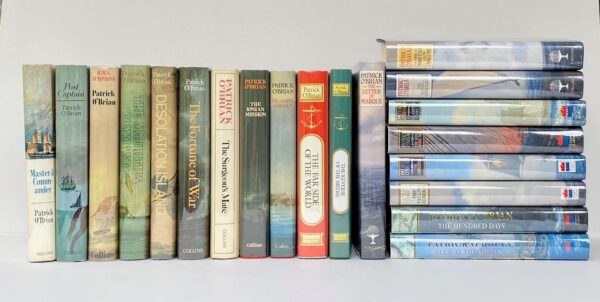
Complete set of Jack Aubrey & Stephen Maturin novels [The Far Side of the World is unclipped; two volumes SIGNED by the Author, most books and jackets in Fine condition]
O'BRIAN, Patrick Twenty Volumes, all are First edition, First impressions. Octavos, bound in cloth covered hard boards and in the original publisher's dust jackets. Overall this is a very pretty, bright and clean set, with most of the books and jackets in fine condition. The Far Side of the World has its original publisher's printed price (£8.95 net) present to the front flap. Clarissa Oakes and The Commodore are both SIGNED by the Author. None of the books have any previous owner names, inscriptions, bookplates or other markings. Comprises the following: Master and Commander - Very Good book (spotting to edges) in a Near Fine unfaded dust jacket; Post Captain - Fine book in Fine dust jacket; HMS Surprise - VG+ book in VG+ dust jacket, which is unfaded to the spine, but has a short closed tear to the rear panel; The Mauritius Command - VG+ book (small mark to ffep) in Near Fine dust jacket (slight fade to spine); Desolation Island - Fine condition book in Fine dust jacket; The Fortune of War - Fine condition book in Fine dust jacket (no fade to spine); The Surgeon's Mate - Near Fine book in Near Fine jacket; The Ionian Mission - Fine condition book in dust jacket which has been clipped and has a publisher's price sticker (£7.95). Jacket has none of the usually found spine fade and grades Fine other than for the clip; Treason's Harbour - Fine book in Fine dust jacket. Beautiful, as new, copy; The Far Side of The World - Fine condition book in Fine unclipped jacket (£8.95 net). Paper not toned as often found and jacket has no spine fade; The Reverse of the Medal - Fine condition book in Fine dust jacket; The Letter of Marque - Fine condition book in Fine dust jacket; The Thirteen Gun Salute - Fine condition book in Fine dust jacket. The jacket is unclipped, unpriced and has a publisher's price sticker on the flap (£11.95); The Nutmeg of Consolation - Fine condition book in Fine dust jacket; Clarissa Oakes - Fine condition book in Fine dust jacket. SIGNED by the Author to the title page. Laid in is a folding card promoting "An Evening with Patrick O'Brian at the Boston Atheneum, 12 November 1993"; The Wine Dark Sea - Fine condition book in Fine dust jacket which is unclipped but unpriced; The Commodore - Near Fine book, which is a little tanning to the paper in Fine condition dust jacket. SIGNED to the title page by the Author; The Yellow Admiral - Fine condition book in Fine dust jacket; The Hundred Days - Fine condition book in Fine dust jacket; Blue at the Mizzen - Fine condition book in Fine dust jacket.- $8,883
- $8,883
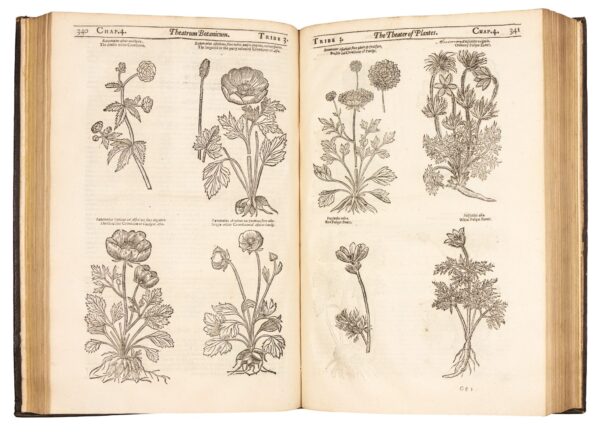
Theatrum Botanicum: The theater of plants.: Or, An herball of a large extent: containing therein a more ample and exact history and declaration of the physicall herbs and plants that are in other authours, encreased by the accesse of many hundreds of new, rare, and strange plants from all the parts of the world, with sundry gummes, and other physicall materials, than hath beene hitherto published by any before; and a most large demonstration of their natures and vertues. Shevving vvithall the many errors, differences, and oversights of sundry authors that have formerly written of them; and a certaine confidence, or most probable conjecture of the true and genuine herbes and plants. Distributed into sundry classes or tribes, for the more eas
HERBALS. BOTANY. MEDICINE. Parkinson, John (1567-1650) Illustrated with an additional, pictorial title page engraved by William Marshall (fl. 1617-1650) and 2716 woodcuts of plants. Bound in fine late seventeenth-century black morocco, paneled gilt, with a central lozenge featuring acorns and large scrolling tools at the corners, spine gilt in compartments, gilt red morocco labels, endcaps neatly restored, the leather along the hinges worn. Complete with the terminal errata leaf; bifolium 4C3-4 apparently supplied to rectify a binding error in which lvs. 4C2 and 4C5 were bound in twice (manuscript note to that effect); eighteenth- or early 19th century ownership inscription to each volume of "R. James", with scattered annotations in his hand throughout (adding Latin names and some cross-references). Clean marginal tears (no loss) to lvs. F4, Ttt5, and 5G6; clean tear in text (no loss) to leaf Vvv5. A handful of leaves lightly toned; occ. rust spots (with one tiny hole on leaf Nn4 and another on leaf Nnnn6; slightly larger rust holes on 6R4-6, one on each leaf). Nnnn5, Vvvv5-6 marginal dampstain. Second volume with some light toning and some shine-through from the woodcuts. The gardener and apothecary John Parkinson (1567-1650) received the title of Royal Apothecary from King James I. Later, Charles I appointed him as his chief botanist. "Throughout his long working life, John Parkinson earned his living and reputation as an apothecary, preparing and dispensing plant-based and other medicines from his shop on Ludgate Hill, as well as growing and cultivating the plants that were the essential tools of his trade on a substantial plot in Long Acre near Covent Garden, further outside the London city walls to the west."(Jill Francis, John Parkinson: Gardener and Apothecary of London, p. 229) "Parkinson's 'Theatrum' was the largest herbal in English to date; it was also the last great medicinally-based plant study, by an author who thought of himself as first and foremost an apothecary. Altogether 2,716 woodblocks were individually cut for this massive herbal, which describes more than 4,000 plants, most of them with medicinal properties. Parkinson had given notice of his intention to compile an herbal in his 'Paradisi in sole Paradisus terrestris' of 1629, but was delayed by the publication of the second Johnson edition of 'Gerard's Herball' in 1636. This delay meant that Parkinson's work had time to grow much larger than originally planned, and on publication it included about 1,000 more plants than Gerard's, and describes many species not previously recorded."(Tomasi, Oak Spring Flora, p. 160) "[The herbal] was a monumental work drawing on Parkinson's 50 years of experience of growing and working with plants. Although working within a traditional genre, Parkinson's great herbal was firmly rooted in the new empirical methods of scientific observation and experiment. "According to Parkinson, [earlier writers of herbals, such as William Turner] presumed a knowledge of the new plants arriving from overseas - often as little more than seeds, roots or dried specimens -but they cannot possibly have understood or seen for themselves the nature of the plant. As he writes elsewhere, 'some of these errors are ancient, and continued by long tradition, and others are of later invention, and therefore more to be condemned'. Parkinson, on the other hand, actually took the seeds, bulbs and roots and planted them in his own garden in Long Acre to observe how they grew and what they looked like. Some he received via fellow gardeners: for instance, his friend John Tradescant sent him a root of Indian Moly to plant in his garden. On another occasion, in 1608, Parkinson commissioned the plant hunter William Boel to seek out for him new species of plants while travelling in Spain and he returned with over 200 different kinds of seeds. Parkinson wrote that 'by sowing them [I] saw the faces of a great many excellent plants'. It was in this way, by careful scientific method, that he built up his extensive kno- $18,000
- $18,000

Lucubrationes, ab innumeris mendis repurgatae. Utopiae libri II. Progymnasmata. Epigrammata. Ex Lucinao conversa quaedam. Declamatio Lucianicae respondens. Epistolae. Quibus additae sunt duae aliorum Epistolae, de vita, moribus & morte Mori
More, Thomas, Saint (1478-1535) With the woodcut illustration of the island of Utopia. A fine copy in 16th c. English calf (re-cased, small repairs, later gold lettering on spine, endpapers renewed. One of the original pastedowns- the leaf from an early English almanac -is visible on the inner rear board.) An excellent copy, the vast majority of the text very fresh, with just some very minor faults: inner margin of title page repaired (far from the text), light stain along top blank edge of first 4 lvs, slight marginal fraying to first 3 lvs., small stain on leaf p8, very light dampstain to the final three gatherings, very small marginal tears to final 3 lvs. The woodcut illustration of the Island of Utopia is on leaf d3. Printer's device on final leaf, verso. Bookplate: "William Salkeld, Esq.", possibly the Serjeant-at-law and law reporter of that name (1671-1715). First edition of the collected Latin works of Sir Thomas More, including the "Utopia" illustrated with a full-page woodcut map. Among the letters published here for the first time is a letter to Martin Dorpius in which More defends Erasmus' translation of the New Testament from the Greek, thus clearly siding with the enlightened "new learning". It also contains a letter from Erasmus to Ulrich von Hutten which contains details of More's physical appearance. There are 9 letters from More to Erasmus, 1 of which concerns the portrait that Erasmus sent to More so that he could always be with him (See "Gifts for an absent friend" below.) The full-page illustration of the Island of Utopia is based on Ambrosius Holbein's woodcut from the 1518 Froben edition. "Utopia" begins with More's encounter with Raphael Hythloday (whose name means 'teller of tall tales'), a traveler who has just returned from voyages with Amerigo Vespucci. Hythloday tells More of a distant island called Utopia, where all property is held in common ownership, where six hours a day are devoted to work and the rest to recreation, where gold and silver are used not as currency but as the material for making shackles and chamber pots, and slaves (criminals and prisoners of war) are treated fairly. In its geography and topography, the island bears a striking resemblance to England. There are fifty-four city-states on the island, perhaps mirroring the number of shires in England and Wales (plus London) in More's time, and all are identical in languages, customs, and laws and similar in size, layout, and appearance. "More positioned his country somewhere in the New World (or, at least beyond the limits of the currently known world), for he states that his narrator, Raphael Hythlodaeus, participated in the last three of Amerigo Vespucci's four voyages. On the final voyage, Hythlodaeus did not come home with Vespucci; rather, he continued his explorations and ultimately discovered Utopia, where he lived for five years before, miraculously, returning to Europe on a Portuguese vessel. Hythlodaeus's descriptions of his residence in Utopia provide the heart of the piece."(Delaney) Gifts for an absent friend: The Portraits of Erasmus and Gillis: The volume also includes Thomas More's letters to Peter Gillis (in whose garden More had conceived of the "Utopia") and Erasmus, in which he thanks his friends for the portraits of themselves that they had sent to More as gifts. The two men had commissioned the leading Antwerp painter of the day, Quentin Matsys, to paint the two portraits as a dyptich. The idea behind the gift being that, through these portraits, Erasmus and Gillis could always be close to their friend. More received the paintings in October 1517 at Calais (where he was on embassy for Henry VIII.) "More wrote from Calais to thank each donor, asking each to show his letter to the other. He surely took his new treasure with him when he returned to London in December. More's letter to Erasmus acknowledges receipt of the diptych (tabula duplex), praises the artist's handiwork and rejoices at his own good luck in having such friends. His letter- $16,000
- $16,000

Phonurgia Nova sive Conjugium mechanico-physicum artis & naturae paranympha phonosophia concinnatum. quâ universa sonorum natura, proprietas, vires effectuúm[que] prodigiosorum causæ, novâ & multiplici experimentorum exhibitione enucleantur : instrumentorum acusticorum, machinarúm[que] ad naturæ prototypon adaptandarum, tum ad sonos ad remotissima spatia propagandos, tum in abditis domorum recessibus per occultioris ingenii machinamenta clam palámue sermocinandi modus & ratio traditur, tum denique in bellorum tumultibus singurlaris hujusmodi organorum usus, & praxis per nouam phonologiam describitur
ACOUSTICS. PHYSICS. Kircher, Athanasius (1602-1680) Bound in contemporary stiff vellum (small repairs to foot of the spine, re-cased, endpapers renewed.) Internally, this copy is in fine condition with only minor faults as follows: half-title soiled, small wormholes in first four lvs., a peppering of small wormholes to final four index lvs. and final blank leaf. Marginal hole (not affecting text) to leaf B3, margins of portrait leaf foxed and with light stain at foot. The volume was re-cased, probably to remove a second, slim work (judging by the size of the overlapping vellum fore-edges of the binding.) Provenance: Engraved armorial bookplate of Augustin Erath (1648-1719), German Augustinian Canon, theologian, translator. The "Phonurgia" is illustrated with an added engraved allegorical title by Georg Andreas Wolfgang (1631-1716) after Felix Cheurier, an engraved title vignette, an engraved portrait of Emperor Leopold I by Wolfgang after Franz Herman, two engraved plates, seventeen engravings and numerous woodcut diagrams and illustrations in the text, musical notation, ornamental woodcut head- and tail-pieces, and decorative initials. Among the illustrations are Michele Todini's "claviorganum" (one of the most technologically advanced keyboards of Kircher's time), Kircher's own musical invention, the "Aeolian Harp", and the invention that inspired the book, Kircher's "Speaking Trumpet" (the megaphone), shown at the shrine of St. Eustace in Monterella. Various chambers with peculiar acoustical properties are also depicted, such as a Vitruvian amphitheater, the courtyard at the Villa Simonetta in Milan and the "ears" of the Tyrant Dionysius of Syracuse. There is also a depiction of one of Kircher's "talking statues", his 17th century intercom. "The 'Phonurgia Nova' is, in part, Kircher's response to Sir Samuel Morland (1625-95), a fellow of the Royal Society of London, who claimed.to have invented the megaphone. Numerous testimonies from Kircher's admirers, such as James Alban Gibbs and Gaspar Schott, are appended to the work defending Kircher's claim as the inventor of the tuba stentorophonica, as Morland called it. Kircher had indeed written extensively on the device in his 'Musurgia' and had been using the 'speaking trumpet' for years at the shrine of Mentorella to call people to services. The 'Phonurgia' treats the science and applications of sound amplification and echoes. It was the first book published in Europe devoted entirely to acoustics." (Merrill). "The importance that the Jesuits placed on sensory experience as part of worship had a significant impact on Kircher's treatment of music. Within the devotional framework, music was valued precisely because of its capacity to move the passions, to produce strong emotional effects that under properly controlled conditions were designed to ravish the soul and lead the faithful closer to the divine. Indeed, Kircher declared that the goal of all music was to move the affections, and this belief goes a long way toward explaining his interest in classifying all the various emotional or affective states that music can imitate. Kircher's was the first systematic account of the 'doctrine of affections' which underpinned early opera and oratorio, and was one of the fundamental assumptions of later Baroque composers such as Bach and Handel."(Penelope Gouk, "Making Music, Making Knowledge: The Harmonious Universe of Athanasius Kircher").- $15,000
- $15,000
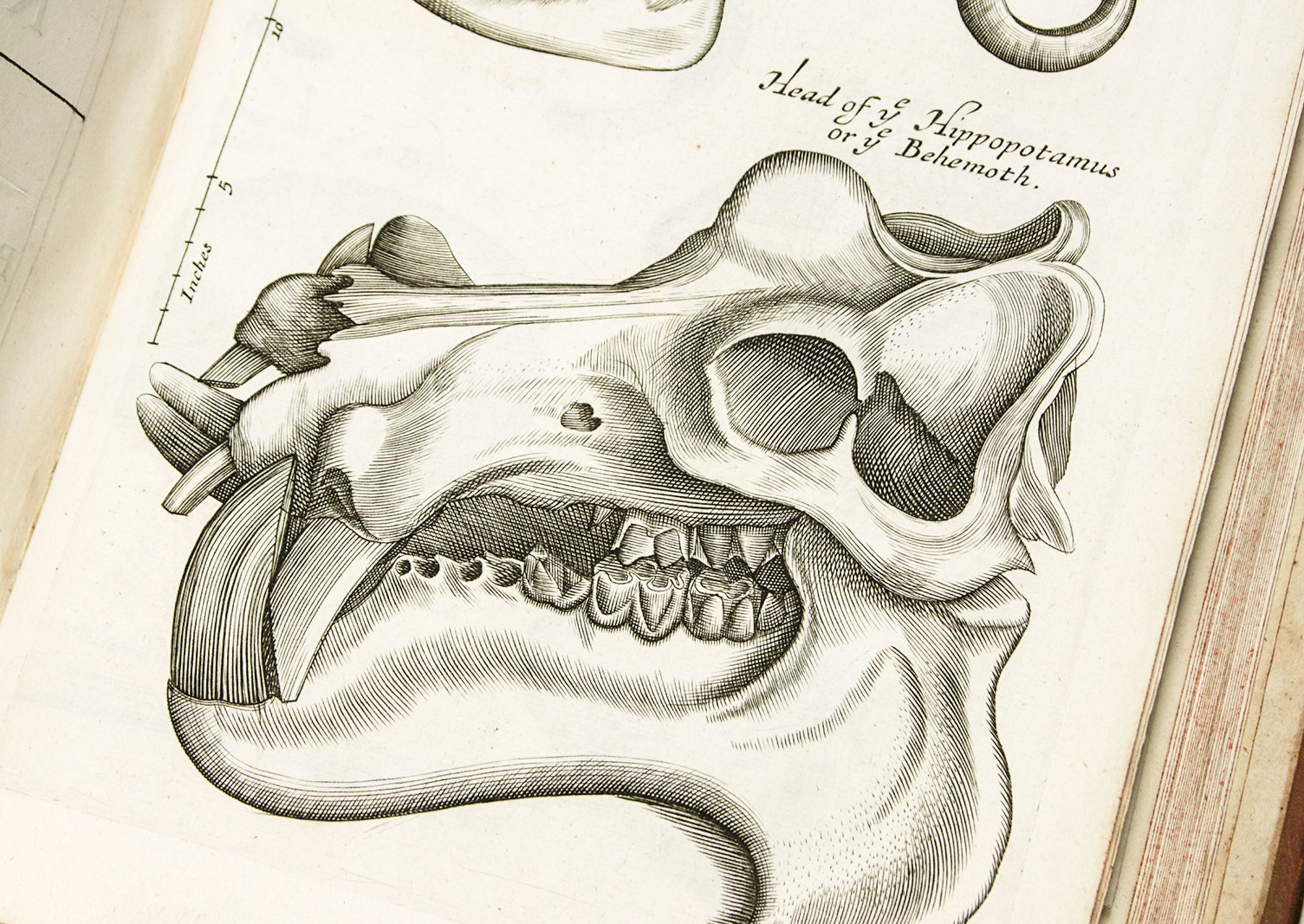
Musaeum Regalis Societatis or a Catalogue & Description Of the Natural and Artificial Rarities Belonging to the Royal Society and preserved at Gresham Colledge. Made By Nehemiah Grew M. D. Fellow of the Royal Society, and of the Colledge of Physitians. Whereunto is Subjoyned the Comparative Anatomy of Stomachs and Guts. By the same Author
Grew, Nehemiah (1641-1712) Including thirty-one full-paged engraved plates (one folding) of the marvelous and exotic subjects of the collections of the Royal Society, and the engraved portrait of the dedicatee Daniel Colwall (d. 1690), the Society's benefactor. Bound in contemporary paneled calf, very nicely rebacked re-cornered, endpapers renewed, some wear to the surface of the boards. An excellent, clean copy. Short worm-trail in the inner margin of the opening leaves, small hole in inner margin of leaf F2. This copy has the usual pen corrections (found in all copies.) Leaf Aa1, Bb1, Pp2 and Pp4 have a few small ink spots (courtesy of the corrector.) Provenance: With the Gaddesden Library bookplate of Sir Walter Halsey (1868-1950). The Gaddesden Library was built 1768 to 1773 by Thomas Halsey, Esq. (1731-1788), in Hertfordshire, England. First edition of the first catalogue of the collections of the Royal Society's collections of ethnographic objects and natural history specimens. At the core of the collection are the donations from the "curiosity cabinets" of the Society's membership, and Robert Hubert's cabinet of "natural rarities", purchased in 1665. The catalogue is the work of Nehemiah Grew, one of the most distinguished scientists of the 17th century, best known for work in plant anatomy, and one of the earliest comparative anatomists to use the microscope. This book also includes his study of the digestive organs, "the first zoological book to have the term 'comparative anatomy' on the title page, and also the first attempt to deal with one system of organs only by the comparative method." (Garrison-Morton 297). The illustrations include a hippopotamus skull, the buttock skin of a rhinoceros, tortoise shells, the skeleton of a crocodile, the sea unicorn, a coconut, fish, bird's nests, shells, insects, and more. American Specimens: Grew describes numerous American specimens, and many are illustrated. There are descriptions of "Virginian money" (a string of hare's teeth), wampum, maize, and a sloth that breeds in Florida. Illustrations include an armadillo, Indian plum stone, coconut, Indian filbert, Butter Nut, and an Indian gourd. "The Sloath. Ignavus sive Pigritia. An Animal of so slow a motion, that he will be three or four days, at least, in climbing up and coming down a Tree. And to go the length of fifty Paces on plain ground, requires a whole day. The Natives of Brasile call him Haii, from his voice of a like sound: which he commonly repeats about six times together, descending, as if one should sing, La, sol, fa, mi, re, ute Whatsoever he takes hold of, he doth it so strongly (or, rather stifly) as sometimes to sleep securely while he hangs at it. See his Description in Clusius, Marggravius, Piso, and others. They all seem to omit the length of his fore feet, which is almost double to that of his hinder. From the shag of his Body, the shape of his Legs, his having little or no Tail, the slowness of his gate, and his climbing up of Trees, as little Bears are us'd to do, he seems to come near the Bear-kind: from which he chiefly differs, In having but three Claws upon a foot. He breedeth principally in Florida and Brasile". (p. 11) "Several sorts of Indian money, called Wampam-Peage. 'Tis made of a sort of Shell, formed into small Cylinders, about a ¼ of an inch long, or somewhat more or less: and so being bored, as Beads, and put upon Strings, pass among the Indians, in their usual Commerse, as Silver and Gold amongst us. But being loose, is not so currant". "A string of Virginian Money. A Row of Teeth in shape like the fore-Teeth of a Hare: all woven together at one end, with brown twisted thread, into one piece ¼ yard long."(p. 370) "Several Spikes or Heads of Mayz or Indian-Wheat; with the Grains, as is not unusual, of three or four colours. The Description of the Plant, with a large Account of its Culture, and Use, were communicated by Mr. Winthrop sometime since Governour of Connecticut in New England: and by me lately published, i- $12,500
- $12,500
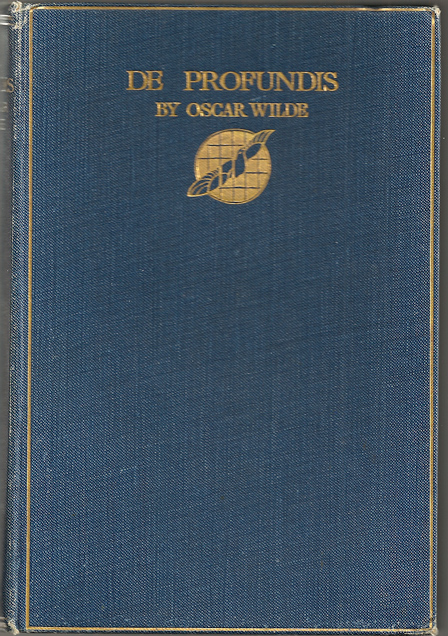
De Profundis
WILDE, Oscar Preface by Robert Ross. Arguably, this item is the single most important copy of the First Edition of Wilde's painful accounting of the effect of social débâcle and imprisonment: the famed Robert Ross copy. The only work Wilde wrote in prison and the last work in prose he ever wrote, the manuscript of which Wilde entrusted to his dear friend, Robert [Robbie] Ross, his sometime lover, most stalwart supporter, and writer of this book's Preface. Avery good copy, albeit quite heavily foxed on the preliminary pages, yet the book's 151 pages following the Preface (plus the Methuen ads following) are quite clean and presentable. .- $950
- $950
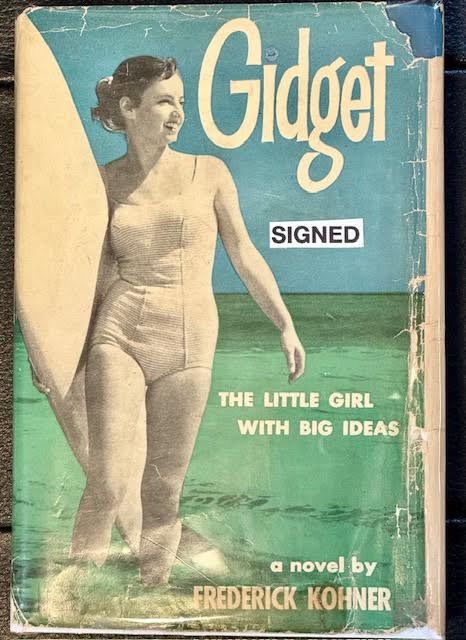
GIDGET The Little Girl With Big Ideas
KOHNER, Frederick Extremely rare true First Edition, First State copy of this treasured cult favorite -- incredibly difficult to find in this condition -- and NEVER seen inscribed and signed by BOTH 'Gidget' as well as the book's author. "To Clare / Best Wishes / "Gidget" as well as: To / Clare E. Butte / Warmest regards and wishes / from the author / Frederick Kohner / Oct. 20th 1957. Copy itself tight, firm, virtually Fine. The highly scarce original pictorial dust jacket is much worn, with random small chips and general use. That said, this scarce First Edition copy of this title is certainly desirable -- and very, very hard to come by.- $2,500
- $2,500
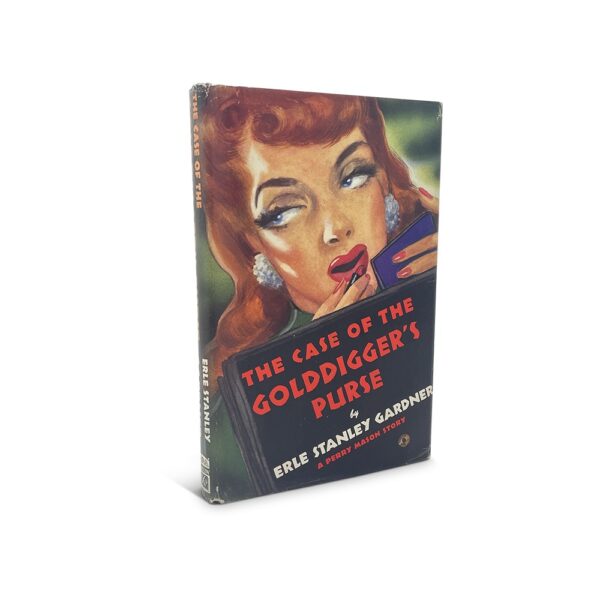
The Case of the Golddigger’s Purse
GARDNER, Erle Stanley 8vo, pp. 218. Original black boards, lettered in black on red to front panel and spine (where the first part of the title is lettered in red on black). Illustrated dust jacket. A fine copy in a near fine dust jacket with just a little fading to spine and the lightest of wear to spine ends. First edition. A Perry Mason title in the almost impossibly prolific Erle Stanley Gardner's bibliography. This is the twenty-sixth title featuring fiction's most famous criminal attorney -- there were eighty-five in all. HUBIN, p. 162- $459
- $459
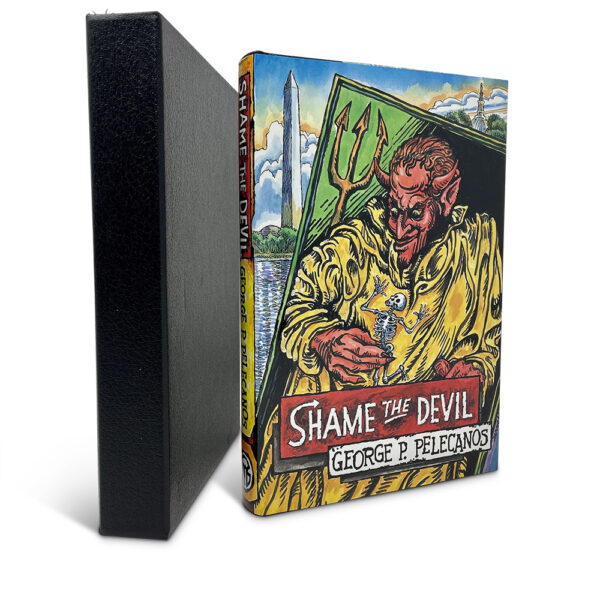
Shame the Devil
PELECANOS, George P. 8vo, pp. 345. Original marbled quarter boards, lettered in gilt to black spine. Black endpapers with devil device in gold. Illustrated dust jacket. Original slipcase. A fine copy in a fine dust jacket and slipcase. Dust jacket design and interior artwork by Joe Servello. First edition, one of 52 quarter bound copies, of a total edition of 452. SIGNED BY THE AUTHOR. The printed limitation states that this is a lettered copy, but no letter has been entered by hand. A fine, unread copy.- $125
- $125

Death notice.
WITTGENSTEIN, Ludwig AN EXCEPTIONAL MEMENTO: THE ANNOUNCEMENT BY HELENE SALZER, BORN WITTGENSTEIN, MARGARET STONBOROUGH, BORN WITTGENTSTEIN, AND PAUL WITTGENSTEIN OF THEIR BROTHER S DEATH IN CAMBRIDGE, ENGLAND, SIX DAYS EARLIER, ON APRIL 29, 1951, AND HIS BURIAL ON MAY 1. In the 1930s and 1940s Wittgenstein conducted seminars at Cambridge, developing most of the ideas that he intended to publish in his second book, Philosophical Investigations. These included the turn from formal logic to ordinary language, novel reflections on psychology and mathematics, and a general skepticism concerning philosophy s pretensions. In 1945 he prepared the final manuscript of the Philosophical Investigations, but, at the last minute, withdrew it from publication (and only authorized its posthumous publication). For a few more years he continued his philosophical work, but this is marked by a rich development of, rather than a turn away from, his second phase. He traveled during this period to the United States and Ireland, and returned to Cambridge, where he was diagnosed with cancer. Legend has it that, at his death in 1951, his last words were Tell them I ve had a wonderful life (Monk: 579) (Stanford Encyclopedia of Philosophy). Born in Vienna into one of Europe s richest families, Ludwig Wittgenstein, his three sisters (a fourth died as a baby) and four brothers received a Catholic education, taught at home in an exceptionally intense environment, and an environment that deeply marked all of them. Ludwig inherited a fortune upon the death of his father in 1913. He initially made some donations to artists and writers, and then, in a period of severe personal depression after the First World War, he gave away his entire fortune to his brothers and sisters. Three of Ludwig s four brothers Hans, Rudi, and Kurt - committed suicide, which Wittgenstein had also contemplated; Hermine died in February 1950, a little over a year before her famous and youngest brother. Ludwig s death is here jointly announced by all of his surviving siblings, Helene, Margaret, whose husband, Jerome Stonborough also had committed suicide 13 years earlier, and Paul. The note mentions Ludwig to have succumbed on Sunday, April 29, after prolonged grave illness, and after having received the last rites. The latter note is of some interest regarding Wittgenstein s faith and relationship with Christianity, which changed over time. Baptized and educated a Catholic, he lost his faith and became an atheist whilst attending the Realschule in Linz as a teenager in 1903-1906. It is also well documented though, that whilst resisting formal religion, he was always sincerely disposed towards religious faith, developing a deepening spirituality with age. The end of the notice prints the siblings respective addresses: Vienna IV, Brahmsplatz 4 for Helene, Vienna III, Kundmanngasse 19, for Margaret, and New York 25, 310 Riverside Drive for Paul, who had fled to America in 1938 to spend the rest of his life there, following charges of racial defilement. This death note was never posted; the original envelope remained unused and is in virgin state. It is thus likely that it remained in the possession of one of Wittgenstein s siblings until it found its way into the open. The number of copies produced was undoubtedly rather small, and sent to close relatives, friends, fellow philosophers, and possibly to members or heads of institutions concerned or involved with Ludwig s work only. Its ephemeral nature much impedes the search for other known examples. Various separate searches on KvK, OCLC, or the catalogue of the Austrian National Library locate no copies though.- $11,158
- $11,158
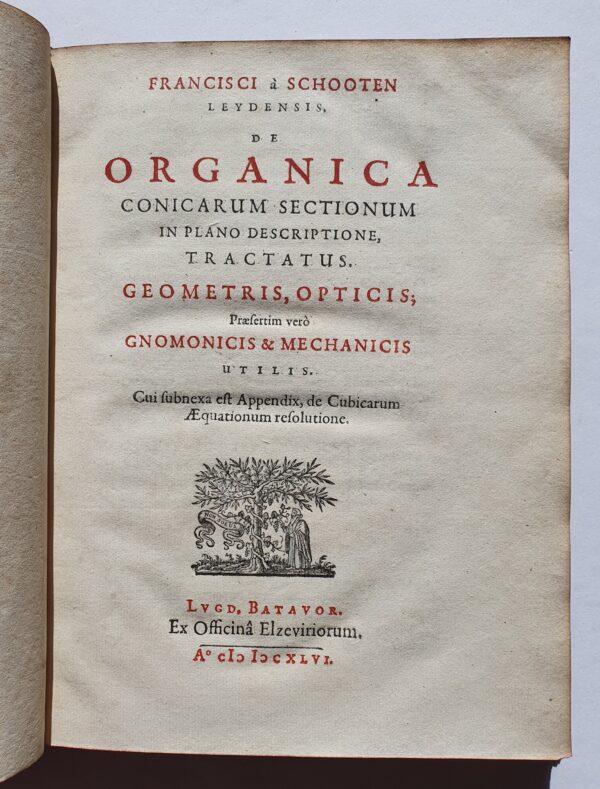
De Organica Conicarum Sectionum in Plano Descriptione, Tractatus. Geometris, Opticis, Prasertime verò Gnomonicis Mechanicis utilis. Cui subnexa est Appendix, de Cubicarum Aequationum resolution
SCHOOTEN, Frans van The de Thou copy of van Schooten's work on conic sections, a work studied by Newton. 'Schooten's first independent work was a study of the Kinematic generation of conic sections (1646). In an appendix he treated the reduction of higher-order binomial irrationals to the form x + √y in cases where this is possible, using a development of a procedure of Stifel's. An interesting problem that Schooten considered was how to construct a cyclic quadrilateral of given sides, one of which is to be the diameter - a problem that Newton later treated in the lectures on Arithmetica universalis (Mathematical Papers, V, 162181). After the death of his father in 1645, Schooten took over his academic duties. He also worked on a Latin translation of Descartes's Géométrie. Although Descartes was not completely satisfied with Schooten's version (1649), it found a broad and receptive audience by virtue of its more carefully executed figures and its full commentary. It was from Schooten's edition of the Géométrie that contemporary mathematicians lacking proficiency in French first learned Cartesian mathematics. Schooten possessed an excellent knowledge of the mathematics of both his own time and earlier periods. Besides being an extraordinarily industrious and conscientious scholar, a skillful commentator, and an inspiring teacher, he was a man of rare unselfishness. He recognized his own limitations and did not seek to overstep them. Fascinated by the personality and ideas of Descartes, he worked hard to popularize the new mathematics; his highly successful efforts assured its triumph. (DSB). This copy stems from the library of Jacques Aguste (II) de Thou, Baron de Meslay, Ambassador to the Netherlands, and 'Président aux Enquêtes', with his gilt arms on covers.- $11,158
- $11,158

Kirchengesanng Teutsch und Lateinisch. In allen Christlichen versamlungen gebreuchlich.
[CHORALES AND HYMNS]. THE SECOND KNOWN COPY OF THIS FINELY PRODUCED PRINTING OF GERMAN CHORALES AND LATIN HYMNS, WITH THE PRINTED LYRICS SIGNIFICANTLY REVISED FROM THE EDITION OF 1557, THE ONLY EARLIER PRINTING. With the beginning of the sixteenth century, European music saw a number of momentous changes. In 1501, a Venetian printer named Ottaviano Petrucci published the first significant collection of polyphonic music, the Harmonice Musices Odhecaton. A. Petrucci s success led eventually to music printing in France, Germany, England, and elsewhere. Prior to 1500, all music had to be copied by hand or learned by ear; music books were owned exclusively be religious establishments or extremely wealthy courts and households. After Petrucci, while these books were not inexpensive, it became possible for far greater numbers of people to own them and to learn to read music From about 1520 through the end of the sixteenth century, composers throughout Europe employed the polyphonic language of [the Franco-Flemish composer] Josquin s generation in exploring musica expression through the French chanson, the Italian madrigal, the German tenorlieder, the Spanish villancico, and the English song, as well as in sacred music. The Reformation and Counter-Reformation directly affected the sacred polyphony of these countries. The Protestant revolution (mainly in Norther Europe) varied in the attitudes toward sacred music, bringing such musical changes as the introduction of relatively simple German-language hymns (or chorales) sung by the congregation in Lutheran services (Rebecca Arkenberg, Music in the Renaissance, the MET, online). Contained here are 84 German chorales, including 31 by Luther, and 64 Latin hymns, including the Magnificat set to 4 voices. VD 16 ZV 21307 (recording a copy at the Staatsbibliothek, Berlin, the only other known copy of this printing).- $15,752
- $15,752
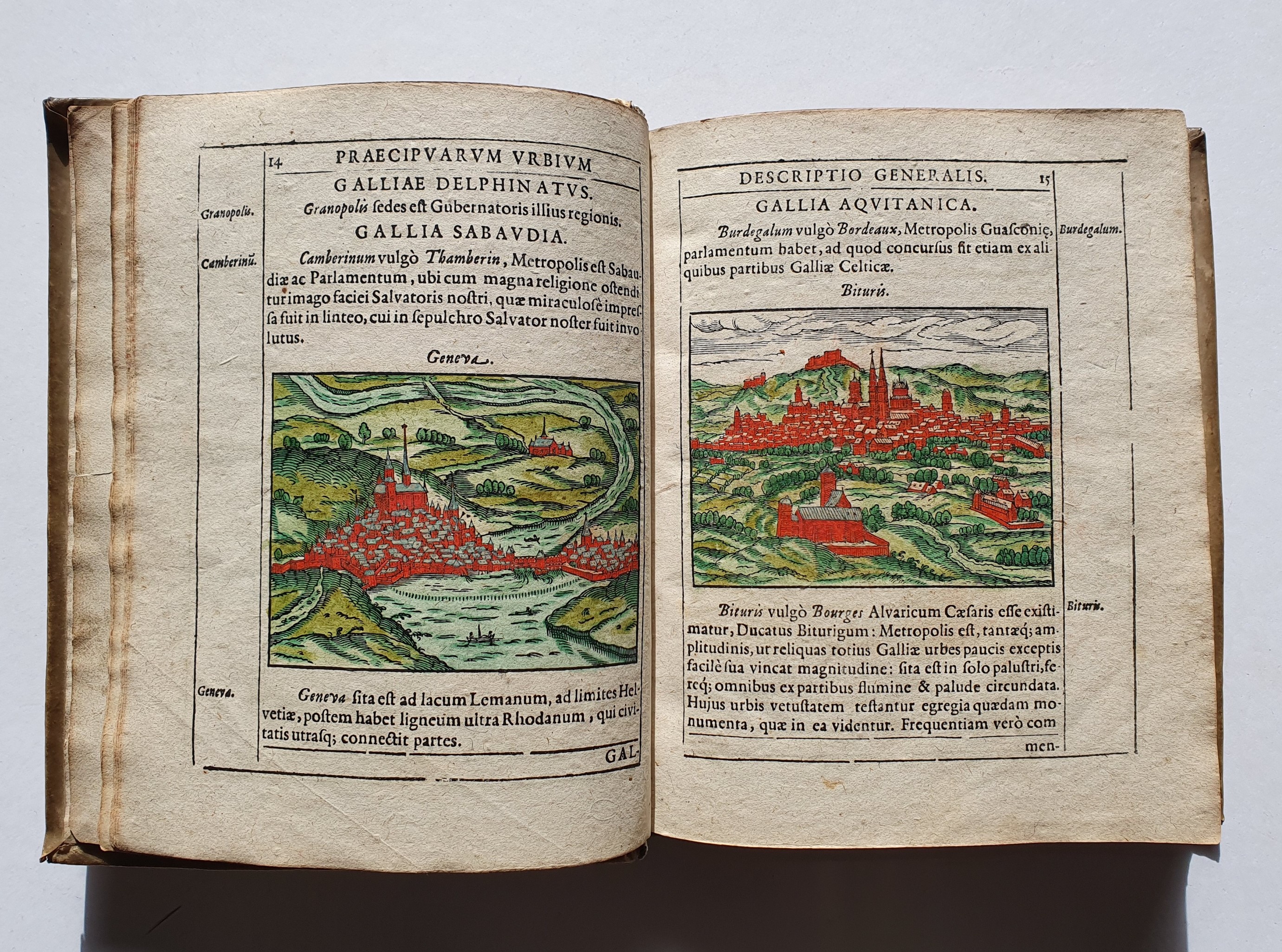
Parvum theatrum urbium sive urbium praecipuarum totius orbis brevis et methodica descriptio.
ROOMEN, Adriaan van [Adrianus ROMANUS] FIRST EDITION, AND A VERY APPEALING COPY WITH THE WOODCUTS HERE FINELY COLOURED, OF THE FAMOUS FLEMISH PHYSICIAN AND MATHEMATICIAN S LATIN TOWN BOOK. Whilst the woodcuts are largely identical to Abraham Saur s German version, but with some omitted or added, this Parvum theatrum urbium is not a Latin edition of the German work published by the same printer in German language. The author of the small town book had died in 1593 and was not available for a Latin edition [and] so the publisher secured A. Romanus from Wurzburg as the author of a Latin text (translated from Fauser). Completely independent from Saur s, van Roomen s text is entirely new, displaying a very different and more succinct approach in his rendition of this geographical work, much reflecting his scientific education and orientation. The work includes 67 European woodcut city views and plans including cuts showing London, Lisbon, Louvain, Antwerp, Brussels, Rouen, Ghent, Lyon, Bordeaux, Paris, Frankfurt, Mainz, Aachen, Heidelberg, Hamburg, Bremen, Hannover, Fulda, Wittenberg, Magdeburg, Nuremberg, Augsburg, Tubingen, Dresden, Worms, Leipzig, Erfurt, Jena, Lubeck, Brunswick, Strasburg, Basel, Geneva, Riga, Rome, Venice, Genova, Prague, Vienna, and Riga, as well as Constantinople, Jerusalem and the tower of Babylon (the final illustration contained). All are in fine colouring, employing red, various shades of green, as well as yellow, purple, and brown, with some delicate and carefully applied heightening in gum Arabic. The work s unillustrated part provides notes on various parts and cities of Russia, Armenia, Assyria, Serbia, Georgia, Albania, Syria, Palestine, Arabia, Persia, Bactria, Afghanistan, Malabar, Ceylon, India, Siam, Cambodia, Korea, China, and Japan, as well as on Java, Sumatra, Borneo, the Moluccas, Japan, and Turkestan. The final pages contain brief descriptions of Florida, New-France, New-Spain, Nova Galicia, Yucatan, Cuba, Brazil, Peru, etc. (Sabin 73000). Adrian van Roomen studied mathematics and medicine in Germany and Italy (he met Christoph Clavius at Rome in 1585, and dedicated his Idea mathematica pars prima, Louvain, 1593, to him). While at Louvain he published the first part of a general work on mathematics and in this he gave the value of pi to seventeen decimal places, an unusual achievement at the time (Smith, History of Mathematics I p. 340). In the same year he obtained a professorship of medicine at Würzburg and subsequently was employed as mathematician of the chapter there. He then went to Prague, was honoured by the Emperor Rudolff II, and travelled to France, where he met Viète. Provenance: early Dutch inscription to title page ( Cornely Deyn (?) Aemstelredamensis ), and a later inscription to front free end-paper. VD 16 R 3024; Adams R 694; Fauser LXIV.- $15,752
- $15,752

Père Ubu
VOLLARD, AMBROISE. Fine copies in original pictorial wrappers preserved in handsome custom clamshell case of black cloth with gilt-lettered spine and front cover in red leather. Vollard has adopted his friend Alfred Jarry?s satirical figure, Père Ubu, in these short plays, mocking the absurdity of World War I. Jarry, dead at the age of 34 in 1907, was a link between the 19th century and the early 20th century avant-garde, influencing the Theater of the Absurd, Duchamp, the Surrealists, Rouault, Max Ernst, and William Kentridge. He coined the term and concept of pataphysics: the science and philosophy of the absurd, using irony and whimsey to examine imaginary phenomena and symbolic truths. LE PÈRE UBU À L'HOPITAL. Two copies: Paris: "Cette Petite Tragédie N?est Pas Mise dans le Commerce", 1917, and Paris: Éditions Georges Crès, 1918. Both with cover, frontispiece, and title page vignette (black in 1917 and red in 1918) by Pierre Bonnard. LE PÉRE UBU À L?AVIATION. Paris: Georges Crès. 1918. Cover illustration repeated on title page and vignette on first page of text by Pierre Bonnard. INSCRIBED BY VOLLARD: AHOMMAGE À L?AUTEUR. LE POLITIQUE COLONIALE DU PÈRE UBU. Paris: Georges Crès. 1919. Cover illustrated by Georges Rouault repeated on title page. LE PÈRE UBU À LA GUERRE. Paris: Georges Crès, 1920. One of 500 copies on holland paper, out-of-series and unnumbered. Uncut and unopened. Shadow of wrappers on endpapers. Cover illustration, title page, and full-page plate by Jean Puy. A GROUP OF FIVE PLAYS WRITTEN BY ONE OF THE GREATEST CONTEMPORARY ART DEALERS OF THE TWENTIETH CENTURY- $1,500
- $1,500

COLLECTION DES PLUS BEAUX NUMÉROS DE COMOEDIA ILLUSTRÉ ET DES PROGRAMMES CONSACRÉS AU BALLETS & GALAS RUSSES DEPUIS LE DÉBUT A PARIS 1909-1921
BALLETS RUSSES Folio, green silk over thick beveled boards with large inset color illustration from Natalia Goncharova's design for "Firebird". Endpapers color- stenciled with names of the dances, dancers, composers, and choreographers, and in the center that of the impresario Serge Diaghilev. Silk faded; a little edge wear to bottom of front board. An exceptionally nice copy of this magnificent book. A compilation of the most important special issues of the theatrical periodical "Comoedia Illustré" and souvenir programs for the 1909-1921 seasons of the Ballets Russes, compiled by the program publishers themselves, Maurice and Jacques de Brunoff, Explanatory forewords by the critic Valerian Svetlov. Lavishly illustrated with photographs and black and white and splendid color plates, some heightened with gilt and silver, of the dancers, costumes and stage decor. Work by Léon Bakst, Valentine Hugo, André Derain, Alexandre Benois, Mikhail Larionov. Natalia Goncharova, José Sert, Henri Matisse, and Pablo Picasso. Dancers include Vaslav Nijinsky, Tamara, Karsavina, Michael and Vera Fokine, and Ida Rubenstein. Léon Bakst's brilliantly exotic and vivid designs for costumes and stage design revolutionized theater and fashion in the first quarter of the 20th century, drawing on Neo-Russian, Orientalist, and ancient Greek motifs. The May 1917 issue is devoted primarily to the ballet "Parade". In his introduction, "Parade et l'Esprit Nouveau", Guillaume Apollinaire coins the term "surrealism", laying the foundation for this movement. "Parade" is a collaboration among Erik Satie, Jean Cocteau, Pablo Picasso, Léonide Massine, and Serge Diaghilev. Picasso's costumes are depicted in two pochoir-colored plates: "Costume de Chinois" and "Costume d'Acrobate". A copy is in the collection of the Metropolitan Museum of Art (rebound without the original cover plaque by Goncharova) and another copy is featured in the 2019 exhibition "Hymn to Apollo/The Ancient World and the Ballets Russes" at the NYU Institute for the Study of the Ancient World.- $5,000
- $5,000

Melvin Edwards: Sculpture (Poster for First Solo Exhibition)
EDWARDS, Melvin Exhibition poster (16 x 11 inches) from Melvin Edwards' first solo show, at the Santa Barbara Museum of Art (Mar. 30-May 2, 1965), where he exhibited sculptural works from his Lynch Fragments series. Illustrated after a striking photograph of Edwards with welding glasses. Slight bump to upper corner and faint foldlines, with postage markings to verso; near fine. Archivally-hinged in black lacquer frame (19 x 13 in.).- $1,500
- $1,500
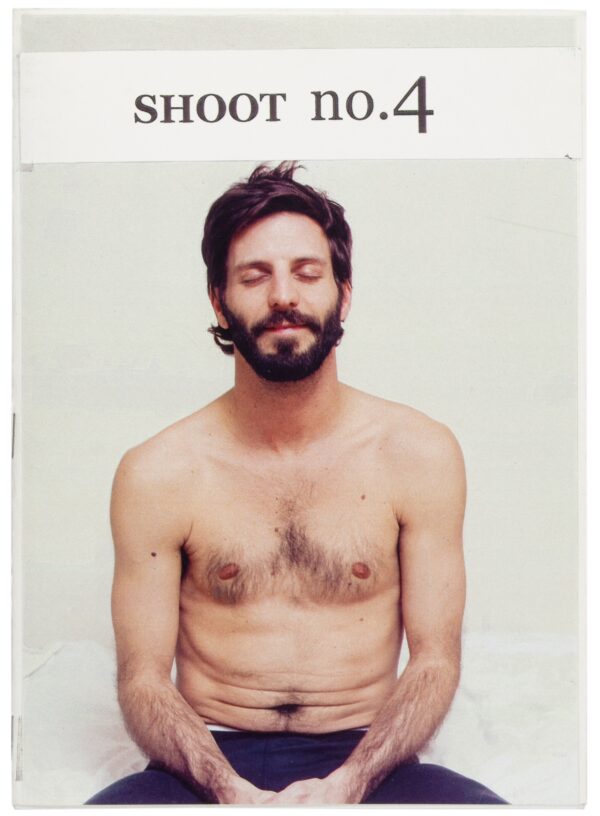
Shoot: No. 4 (with Signed Photo)
SEPUYA, Paul Mpagi Limited Edition. Octavo. Hand-numbered as copy 124/150. The fourth installment of Paul Sepuya's occasional zine, featuring a photoshoot with a topless model named Dean. Interior with 8 black-and-white images and short erotic poem, with covers featuring two additional images in color. (Copy Machine Manifestos, 354-355). Issued with C-print photograph, also numbered 124/150 to verso and SIGNED by Sepuya; dated 2006. Also laid-in, a folded black-and-white offset print, reproducing a doodled-over photo of the model. A fine copy in stapled photo-illustrated wrappers.- $1,200
- $1,200
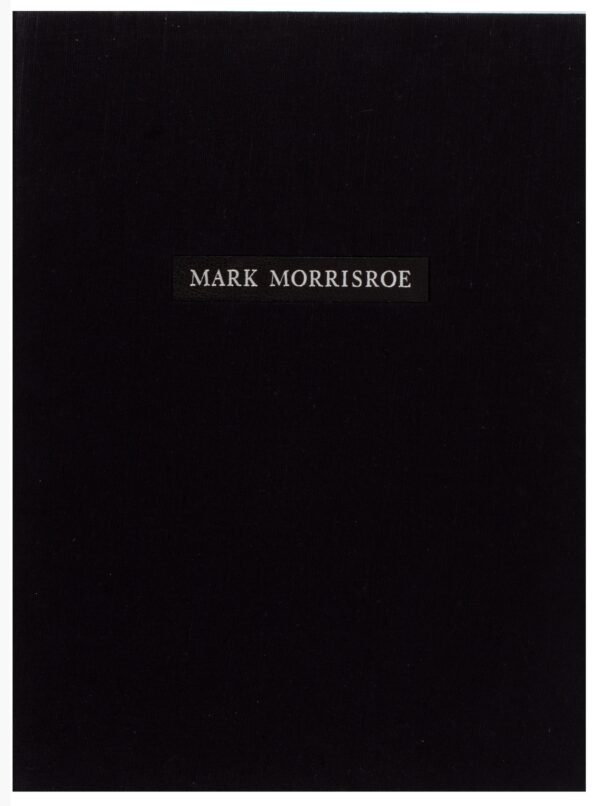
Mark Morrisroe (Portfolio)
MORRISROE, Mark and Nan Goldin First Edition. Folio. A posthumous portfolio of 12 photogravure plates derived from the intimate photographs of Mark Morrisroe (1959-1989); produced by Pat Hearn Gallery (New York), where Morrisroe received his first solo exhibition in 1986. Each of the plates (4.5 x 3.5 in.) printed to handmade sheets (15 x 11.5 in.) and hand-numbered as 11/46 to verso by the Morrisroe Estate. The suite introduced by a statement from Nan Goldin, celebrating her old friend and colleague as "Boston's first punk." The photographs, dating between 1978 and 1986, include two nude self-portraits, portraits of lovers and friends, and a few still lifes. Housed in publisher's cloth clamshell case with leather lettering piece to front panel. A fine copy, including original tissue guards. Scarce, with no OCLC records located. An elegant memorial.- $9,500
- $9,500

Il Disegno della Geografia Moderna de Tutta la Provincia de la Italia.
Giacomo Gastaldi Very rare! The map is engraved by Fabio Licinio. "La piu importante carta dell'Italia apparsa nel XVI secolo". This map represents the most important map of Italy that appeared in the 16th century. It will constitute the cartographic model of the peninsula in Italy for the following century. Almagia defines it as "one of the milestones in the evolution of the cartography of Italy". Gastaldi published the map in 1561, protected by the privilege that he obtained from the Venetian Senate on 29 July 1559. The map contains many improvements over previous maps. Old folds, a few reinforcements at the back, some light spotting in places, very good condition. Copper engraving, printed on paper from two plates, joined. Right plate seems to be trimmed a bit (cf. images in Bifolco-Ronca). Two watermarks: pilgrim in circle. Size (not including margins): 535 x 765mm (21.06 x 30.12 inches). Verso: Blank. Bifolco-Ronca, Tav. 911 State 1 (of 2)- $44,712
- $44,712
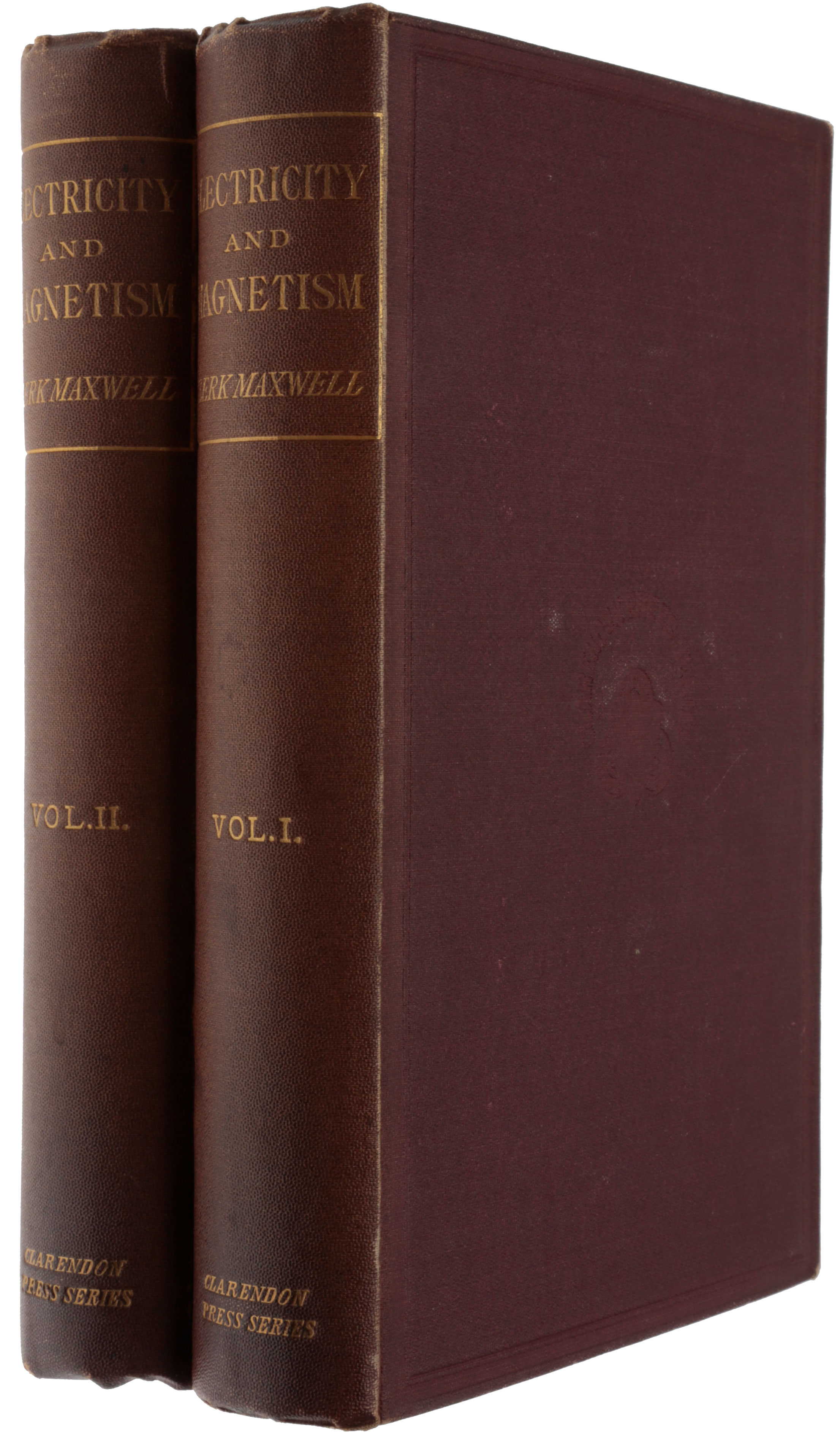
A Treatise on Electricity and Magnetism
MAXWELL, James Clerk PMM 355 - LIGHT AS A FORM OF ELECTRICITY. First edition of Maxwell's presentation of his theory of electromagnetism, advancing ideas that would become essential for modern physics, including the landmark "hypothesis that light and electricity are the same in their ultimate nature" (Grolier/Horblit). "This treatise did for electromagnetism what Newton's Principia had done from classical mechanics. It not only provided the mathematical tools for the investigation and representation of the whole electromagnetic theory, but it altered the very framework of both theoretical and experimental physics. It was this work that finally displaced action-at-a-distance physics and substituted the physics of the field" (Historical Encyclopedia of Natural and Mathematical Sciences, p. 2539). "From a long view of the history of mankind - seen from, say, ten thousand years from now - there can be little doubt that the most significant event of the 19th century will be judged as Maxwell's discovery of the laws of electrodynamics" (R. P. Feynman, in The Feynman Lectures on Physics II (1964), p. 1-6). "[Maxwell] may well be judged the greatest theoretical physicist of the 19th century . Einstein's work on relativity was founded directly upon Maxwell's electromagnetic theory; it was this that led him to equate Faraday with Galileo and Maxwell with Newton" (PMM). "Einstein summed up Maxwell's achievement in 1931 on the occasion of the centenary of Maxwell's birth: 'We may say that, before Maxwell, Physical Reality, in so far as it was to represent the process of nature, was thought of as consisting in material particles, whose variations consist only in movements governed by [ordinary] differential equations. Since Maxwell's time, Physical Reality has been thought of as represented by continuous fields, governed by partial differential equations, and not capable of any mechanical interpretation. This change in the conception of Reality is the most profound and the most fruitful that physics has experienced since the time of Newton'" (Longair). Issues: The Treatise is found in various forms and publisher's bindings. We know of two different cloth bindings, both certainly official publisher's bindings: one with the arms of Clarendon Press blind stamped to the boards; another slightly brighter cloth without the arms (as the offered copy). The copies in the first type of binding (with arms to the boards) seem always to have advertisements for the Clarendon Press bound in the end of volume 2. These adds can be found in two different forms: one with 'just published' at the entry for Maxwell's Treatise itself, and one not mentioning 'just published'. A copy with the just-published-adds seems always to have the short errata slips in volume 1 and 2. Copies with the adds not mentioning 'just published' seems always to have the extended errata leaves, with further corrections than the errata slips. A set in the blind stamped bindings with just-published-adds and short errata slips are usually said to be first issue and a set with longer errata leaves and adds not mentioning 'just published' are usually called third issue. Sets in the brighter publisher's bindings (i.e., without the arms of the Clarendon Press blind stamped to the boards), which in our experience are rarer than the darker blind stamped form, seem always to be without the advertisements for the Clarendon Press in the end of volume 2. These sets can however be found with the shorter errata slips or with the extended errata leaves (as the offered copy). We have so far been unable to determine the exact chronological order in which these various forms were issued. Hence there seems so far to be two first issues (with short errata slips), two second issues (with extended errata leaves), and one third issue (with adds not mentioning 'just-published)'. "Maxwell's great paper of 1865 established his dynamical theory of the electromagnetic field. The origins of the paper lay in his earlier papers of 1856, in which he began the mathematical elaboration of Faraday's researches into electromagnetism, and of 1861-1862, in which the displacement current was introduced. These earlier works were based upon mechanical analogies. In the paper of 1865, the focus shifts to the role of the fields themselves as a description of electromagnetic phenomena. The somewhat artificial mechanical models by which he had arrived at his field equations a few years earlier were stripped away. Maxwell's introduction of the concept of fields to explain physical phenomena provided the essential link between the mechanical world of Newtonian physics and the theory of fields, as elaborated by Einstein and others, which lies at the heart of twentieth and twenty-first century physics" (Longair). The 1865 paper "provided a new theoretical framework for the subject, based on experiment and a few general dynamical principles, from which the propagation of electromagnetic waves through space followed without any special assumptions . In the Treatise Maxwell extended the dynamical formalism by a more thoroughgoing application of Lagrange's equations than he had attempted in 1865. His doing so coincided with a general movement among British and European mathematicians about then toward wider use of the methods of analytical dynamics in physical problems . Using arguments extraordinarily modern in flavor about the symmetry and vector structure of the terms, he expressed the Lagrangian for an electromagnetic system in its most general form. [George] Green and others had developed similar arguments in studying the dynamics of the luminiferous ether, but the use Maxwell made of Lagrangian techniques was new to the point of being almost a new approach to physical theory-though many years were to pass before other physicists fully exploited the ground he had broken . "In 1865, and again in the Treatise, Maxwell's next step after completing the dynamical analogy was to develop a group of eight equations descr- $16,000
- $16,000
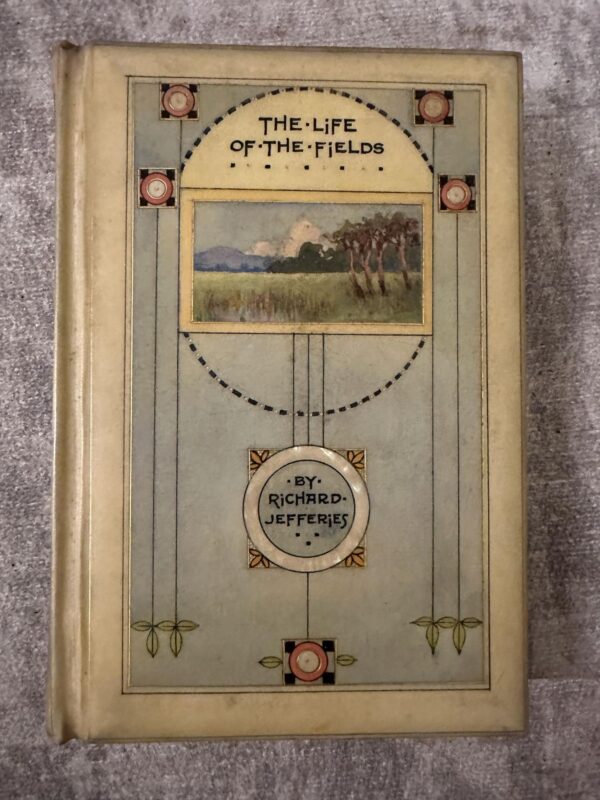
Cedric Chivers “vellucent” binding
Jeffries. R. The Life of the Fields. London, 1908. 8vo. In a Cedric Chivers "vellucent" binding. Some foxing internally. Cedric Chivers (1853-1929) was an innovative English bookbinder and publisher known for his significant contributions to the preservation and restoration of old books. Chivers is particularly renowned for his development of the "vellucent" binding process, where the artwork on a book cover is painted on the underside of transparent vellum, protecting the delicate painting from wear while enhancing the book's aesthetic appeal. Operating out of Bath, England, his work extended beyond craftsmanship to a commitment to library preservation, introducing methods like the "Chivers' Patent" binding which allowed books to lie flat when open, reducing stress on their spines and contributing to their longevity. His dedication to bookbinding and preservation left an enduring legacy in the world of bibliophily and library sciences.- $2,750
- $2,750

1837 Book on Pirates
THOMAS (R.) An Authentic Account of the most Remarkable Events: Containing the lives of the most noted Pirates and Piracies. New York, 1837, Collation pp. (2), 5--298, 12 plates; (2), 5--359, (1), 13 plates. Binding: plain red cloth; internally some general foxing throughout. A Rare American book on Pirates.- $700
- $700
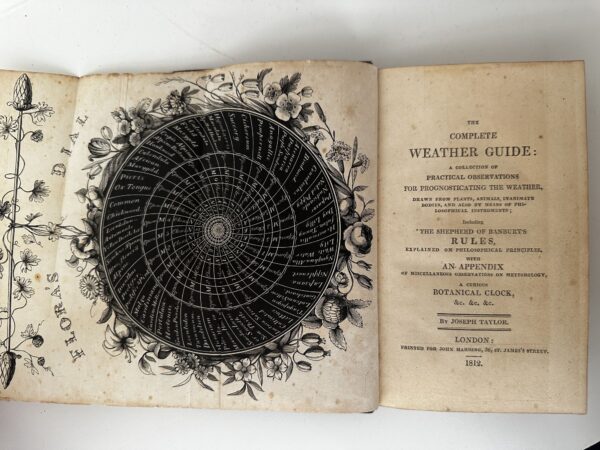
1812 Book on Weather Prediction
[WEATHER PREDICTION]). TAYLOR, JOSEPH. The Complete Weather Guide: a Collection of Practical Observations for Prognosticating the Weather, Drawn from Plants, Animals, Inanimate Bodies, and Also by Means of Philosophical Instruments. London: for John Harding, 1812. First Edition. Small 8vo, 16 x 9.5 cm. Early calf and marbled boards, somewhatrubbed. The beautiful and unusual engraved folded frontispiece of "Flora's Dial". is present explaining when various flowers close or open. RARE. The book contains a compilation of folklore, scientific observations derived from plant studies, and basic knowledge of barometric instruments. Although it was reprinted multiple times in later years, the initial edition was quite rare.- $450
- $450
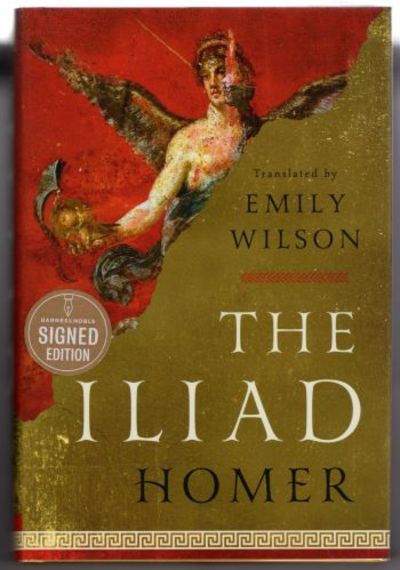
THE ILIAD
Wilson, Emily (trans.) NY, 2023 First edition, first prnt. Signed by Wilson on the title page. Introduction. Translator's Note. Maps. Notes. Genealogies. Glossary. "Signed Edition" sticker on dustjacket front panel and correct isbn sticker on rear panel as issued; one of an unspecified number issued as such. Bumped upper and lower rear board/spine corners (but no corresponding wrinkles on the dustjacket); unread copy in Very Good condition in a Fine dustjacket with an archival cover. Wilson's much heralded second translation of Homer.- $145
- $145
